- Skip to primary navigation
- Skip to main content
- Skip to primary sidebar
- Skip to footer
Healthy Happy Teacher
Helping hardworking teachers stay healthy and happy.

How to Write a Counterclaim [Explained Simply!]
Counterclaims are an essential part of a top-notch argumentative essay. After all, they show that you’ve thoroughly researched and considered both sides of the issue before deciding on your particular stance.
There’s just one problem: they can be a little tricky to write without weakening your main argument, as you may already be aware!
That’s why we put together this guide on writing a counterclaim that will only enhance your position in an argumentative essay and not take anything away from it.
By the end of this article, you’ll be writing counterclaims like a pro – and get that grade you deserve on your next paper. Let’s get started!
What Is a Counterclaim in Writing?
Before we get into how to write one, let’s clarify what we mean by “counterclaim.” In writing, a counterclaim is an opposing argument that goes against the thesis statement of a paper.
It shows your audience that you have researched the topic thoroughly by looking into both sides of the issue and that you’re not trying to hide any important information that refutes your thesis.
Not only that, a well-written counterclaim can even help you win over those who don’t agree with your main claim or argument – especially when you make some good points in your rebuttal paragraph (which we will get into as well).
For example, let’s say you’re writing an argumentative essay on the use of cellphones in schools. If your claim is that they should be allowed at all times because they can help support learning, then the counterclaim could be that they’re more distracting than anything else.
How to Write a Counterclaim
The key to excellent argumentative writing is to make your position convincing and clear while acknowledging – not to mention rebutting – the counterarguments. Fortunately, you can break down the process of crafting a great counterclaim into four simple steps:
1. Research, Research, Research
Of course, a thorough understanding of your position on the topic is essential, but you should also have a good grasp of the main arguments of your opponents.
It’s not enough to just know what the arguments are – you need to know why other people feel this way.
For example, going back to our cellphone paper. If one of the main counterclaims is that cellphones are distracting in schools, you need to find out what is driving these opinions. Are there facts to back it up, or is this purely based on anecdotal evidence?
Once you feel like you have a firm grasp on the opposing view, you can move on to the next step.
2. Determine Where to Put the Counterclaim
A well-written essay typically starts with a few introductory sentences to capture the reader’s attention. Next comes the thesis and the claims (backed with plenty of research and evidence, of course).
By this point, your stance on the issue should be clear, so it’s usually safe to start including your counterclaims in the body of the essay.
As to where exactly you should include your counterclaims, two of the best options include the following:
- In the paragraphs. If your paper has several claims you want to counter, then you may address each one in the paragraphs. This is often most effective right after supporting your claims with evidence and arguments.
- Before the conclusion. This is often the preferred place for counterclaims, especially in shorter essays. It’s a good option because your reader should have a firm grasp of your position at this point, so the counterclaims shouldn’t really weaken your main arguments.
Remember that your counterclaim paragraph(s) should be separate from your introduction and conclusion. As long as it’s outside these areas, your counterclaim should be in a perfectly acceptable position in the paper.
3. Figure Out How Long Your Counterclaim Should Be
It isn’t time to start writing yet! Now that you’ve identified your counterclaim or counterclaims, you need to figure out how much space to devote to it in your essay.
You’ll want to cover the opposing side as concisely as possible, as you don’t want to give them more space than your claims. This is especially important if you have a specific word count; dragging out a counterclaim argument for too long may not leave enough room for you to argue your position properly.
In most cases, one short paragraph per counterclaim should do the trick. Just remember that you need to explain the opposing argument and why others feel this way.
4. Consider How to Present the Counterclaim Fairly
Before you officially start typing things out, one of the most important things to consider is how you will present your counterclaim fairly. You don’t want to present the opposing view with an obvious bias, as it may take away from the credibility of your paper.
And besides, you shouldn’t have to put the other viewpoint down to clarify your stance!
You should have already put lots of strong evidence and arguments in favor of your position throughout your paper, so trying to understand and present the opposing viewpoint fairly shouldn’t weaken your claims too much.
5. Write Your Counterclaim
You’re finally ready to write your counterclaim! The first thing you need to do is include an appropriate transition to help with the flow of your paper.
Some good transitions include:
- Critics have argued that…
- On the other side of the argument, people are concerned that…
- The contrasting viewpoint indicates that…
Once you have chosen an appropriate transition and stated the opposing viewpoint, you can describe why people feel this way. And don’t forget your evidence! As with your claims, you need to show that you’ve done the research to support this position.
From here, you can write your rebuttal explaining any issues or weaknesses with the counterclaim. This is essential to solidifying your original position.
Some suggestions for a good rebuttal include:
- Detailing the particular weaknesses with the counterclaim
- Acknowledging that while these viewpoints have some merit, there is a solution that renders it baseless
- Showing that the benefits of your claims outweigh the risks of the counterclaims
- Pointing out that the benefits of the counterclaim are exceedingly rare
Tips on Writing a Great Counterclaim
Want to make a good counterclaim even better? Remember these tips when writing:
- Objectivity is key. As passionately as you may feel about your position, do your best to remain objective when presenting a counterclaim. For example, avoid saying things like “critics mistakenly believe that…”
- Don’t leave out information on purpose. If you find evidence for your counterclaim supported by research, don’t leave it out of your paper to avoid weakening your argument. Instead, explain why it is weaker than your claims.
- Read through other essays. If you’re still unsure what a good counterclaim looks like, read professional-level papers to see how others have done it.
- A second set of eyes is always helpful! If you can, get someone to read through your paper to make sure your counterclaim is clear, objective, and concise. You may also want their opinion on whether your rebuttal is effective enough to dispute the main points of your counterclaim.
The Bottom Line
Though it may seem daunting, writing an effective counterclaim doesn’t have to be difficult.
Just remember to do your research, avoid putting it in the introduction and conclusion, keep it to a paragraph, present it fairly, and transition into it appropriately.
And most of all, do your best to put any biases aside and remain objective.
By following these tips, writing counterclaims will become second nature to you in no time. Good luck with your next paper!
Reader Interactions
Leave a reply cancel reply.
Your email address will not be published. Required fields are marked *
Save my name, email, and website in this browser for the next time I comment.
Disclosure, disclaimer & privacy policy
As an Amazon Associate, I earn from qualifying purchases
- How It Works
- PhD thesis writing
- Master thesis writing
- Bachelor thesis writing
- Dissertation writing service
- Dissertation abstract writing
- Thesis proposal writing
- Thesis editing service
- Thesis proofreading service
- Thesis formatting service
- Coursework writing service
- Research paper writing service
- Architecture thesis writing
- Computer science thesis writing
- Engineering thesis writing
- History thesis writing
- MBA thesis writing
- Nursing dissertation writing
- Psychology dissertation writing
- Sociology thesis writing
- Statistics dissertation writing
- Buy dissertation online
- Write my dissertation
- Cheap thesis
- Cheap dissertation
- Custom dissertation
- Dissertation help
- Pay for thesis
- Pay for dissertation
- Senior thesis
- Write my thesis
How To Write A Counterclaim For A Successful Result
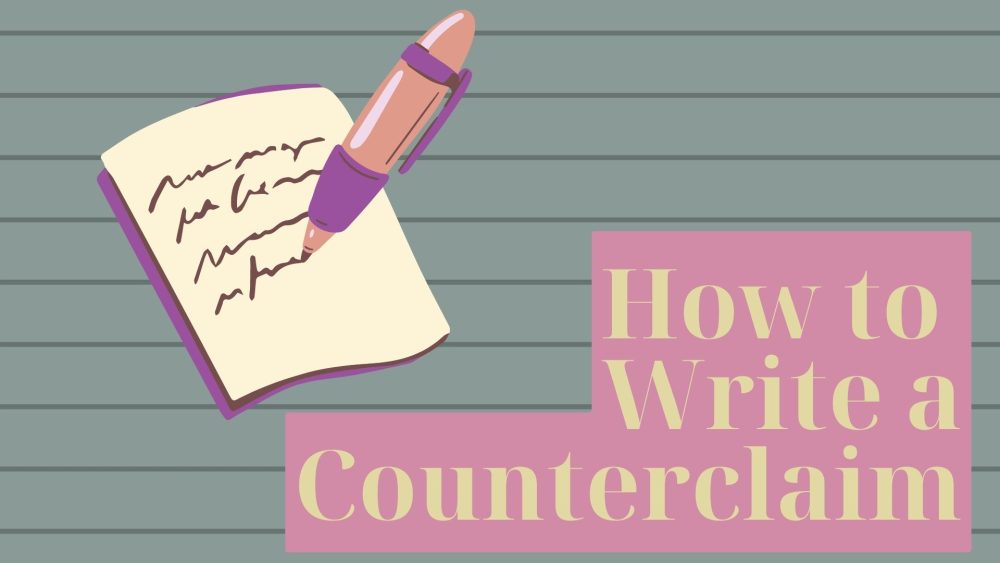
You might have probably heard about a counterclaim or written one that did not go well with you, which is why you are here. We understand your frustrations and anxiety about writing counterclaims, which is why we developed this comprehensive article.
Here is what to expect:
An in-depth explanation of what a counterclaim is The necessity of a counterclaim How to write a good counterclaim Characteristics of an excellent counterclaim Structure and formatting of counterclaims
After reading this post, you will have all the information you need to craft an award-winning paper. We will not leave anything to chance until you know how to write a counterclaim like a top-class student!
Table of Contents
What is a counterclaim in writing, why is a counterclaim necessary, how to write a counterclaim from scratch, detailed guide on how to start a counterclaim paragraph, how to write rebuttal, characteristics of a good counterclaim, example of a good counterclaim.
A counterclaim refers to an argument that opposes the author’s claim. The writer presents the claim and then refutes it, giving reasons why others should not take up the contrary view and agree with their initial stand.
The counterclaim opposes the thesis statement in your essay. So, this is how a counterclaim comes about:
- You first introduce the topic in the introductory paragraph
- Create a thesis statement in the last sentence
- Write a counterclaim that rebuts the initial argument
Many students fail to appreciate the fact that there is a difference between a claim and a counterclaim. The claim demonstrates your position of argument or the assertion of a fact, whereas a counterclaim negates a specific claim by refuting it.
Any top-rated argumentative will always have a counterclaim which disagrees with and disapproves of a claim. Such a claim also provides reasoning that further clarifies a particular argument. The two main purposes of a counterclaim are as follows:
It enhances the credibility of the author: A strong argumentative essay will utilize the rhetorical appeal of ethos. With a counterclaim, a writer will prove that they researched extensively on the topic and are not trying to hide possible information from the audience. It also allows the writer to provide a rebuttal to the essay. The rebuttal is used to disprove the counterclaim within the writer’s argument.
For instance, if the claim is that the government should ban gun use, the counterclaim would be that it should not ban it because it infringes on human rights. There should always be reasons and evidence for you to have a successful counterclaim.
In the next few lines, we will provide all you need to know about starting a counterclaim and delivering the best! So stay tuned.
Every successful essay begins with thorough background research on the topic of discussion. Exploring all possible angles of your essay before embarking on the writing process is recommended—those who end up with a good counterclaim put in extra hours in research and extensive consultation.
You can read thousands of articles on how to write a counterclaim, but without the right background research strategies, that great essay might amount to nothing. So, if you want to crack your counterclaim paragraph like a guru, here are excellent tips for you:
Understand your topic Explore what previous authors have done on it Identify the knowledge gaps Seek facts to defend your claim
Once you have all the information needed for your topic, nothing will stand in the way of you writing a top-notch paper that will impress your professor. When you have factual proof of every statement you make in your essay, you will have a non-biased and credible paper. That means that the sources you use should always be credible and directly relevant to the topic of your essay.
After stating all the base knowledge you need about counterclaims, we now want to dive into the practical part of writing a counterclaim argument. Let’s explore how to write counterclaims by looking at the elements needed:
- The main counterclaim: It states an opposing argument to the claim.
- The evidence includes a previous position to show that others welcome the view.
- An explanation entails providing reasons why people hold the particular view you presented.
- A rebuttal: Here, you will explain the weakness of the counterclaim and present show why your original position is correct.
The process might be challenging initially, but with the right tools and expert advice, you will be up and running in minutes. A counterclaim is included in argumentative writing to address the opposite side of the argument and provide a rebuttal.
The process of writing an outstanding counterclaim in an argumentative essay is as follows:
Where do you put a counterclaim in an essay? Every top-ranking essay begins with a catchy intro comprising statistics or a rather dramatic intro to a particular problem. The thesis statement follows, and the then claim comes on stage. Therefore, the counterclaim comes after you have backed up your claims with evidence and further arguments. How long is the counterclaim? It depends on the number of counterclaims and the overall length of your essay. A typical counterclaim should be at least one paragraph long. Remember that you are not just stating it but explaining why it is so. That is why most guides on writing a counterclaim and rebuttal will recommend either writing them in one paragraph or separately. What different points of view do others hold? You should always understand all the possible points that may arise to counter your claim. Researching why people oppose your claim will give you room for a balanced and reliable paper. It requires a creative mind to determine how your claim goes against the common view. How to introduce a counterclaim now: The general rule is that you should present the contrary opinion fairly. You will only be ready to craft a brilliant counterclaim once you dive into the possible arguments that others who oppose your thesis make. Sincerely present the contrary opinion fairly.
Always remember to use transitions when moving on to present your counterclaim. Just like in a debate, the contrary side will come after the proposers have made their submissions. Therefore, you can begin your counterclaim paragraphs with the following:
- On the contrary, side
- Critics say that
Having presented the other side, you will detail why people also hold that view. It is where the evidence comes in to solidify your counterclaim.
It is advisable to have it in a similar paragraph where your counterclaim is, but if that is not possible, begin it in a new paragraph. However, always remember to keep it short while bringing out the following:
- How the contrary position in your counterclaim is false or weak.
- Presenting the advantages in the counterclaim but giving reasons why the opposite view may not hold water.
- Describe how your main argument outweighs the risks in the counterclaim.
After introducing the counterclaim, you have to discuss why the counterclaim is incorrect. You can start the rebuttal in several ways, such as:
Despite this information Nevertheless However
It is your opportunity to prove why the contrary view is wrong.
You cannot achieve this milestone without considering all sides of the argument first. That is why most researchers in college and university take their time before beginning the writing process. It provides a base for the facts and opinions and saves the time one will spend completing the argumentative essay.
Acknowledging the valid points of the other side is necessary for any form of argumentative writing. This practice eliminates the thought of narrow-mindedness from the reader’s point of view, which may make your essay less effective.
Instead of making your argument look weak, a counterclaim will strengthen your essay by proving that you thoughtfully considered all possible angles before writing your essay. Nobody will accuse you of bias or inadequate research when you have a formulated counterclaim.
A good counterclaim, therefore:
Acknowledges what the opposing side says Provides evidence from the opposing side Refutes the point of view and evidence
It is also crucial to state that when you have more than one claim in your paper, there is always an option of writing a counterclaim for each. You are not limited to presenting the different counterclaims in the same essay. However, follow the structure outline above in terms of length and format.
Additional characteristics of a world-class essay include:
- Objectivity in the language use
- Fairness in the diction
- Evidence to back up the counterclaim
- Fairness in the rebuttal
By validating any underlying concerns, you eliminate room for doubt or error. Remember also to explain why your argument works in that context.
Below is a brief example of what a good counterclaim can look like, from professional dissertation writers :
“On the other hand, some students say homework presents unnecessary stress and pressure. This point of view makes sense because the article states that too much homework may be overwhelming for students, which is why most of them do not complete it. However, homework does not harm the student because the article also says that homework is necessary to test students’ understanding after classroom learning. Therefore, even though homework may cause stress and pressure on the student, it does not harm the student in any way.”
From the example, you can note the following:
Phrases that can begin a counterclaim:
On the other hand, some people say Admittedly, some people say Certainly, some people say
Phrases to refer to the initial claim:
However Nevertheless On the other hand
Phrases to bring paragraph to a conclusion:
Thus Therefore As a result
A good counterclaim will always give you an edge over your competitors in any case.
Writing A Counterclaim Can Be Very Easy
Writing an all-inclusive counterclaim is not a big deal if you have all the facts rights – our writing service and master thesis help offers top-notch assistance with an incredible team of writers and research gurus. We will help you identify winning arguments and provide you with the best rebuttals.
Do not second guess what you will score in your counterclaim essay when you can try out our custom thesis writing service today. Make your pick today and improve your score effortlessly.

Leave a Reply Cancel reply
Your email address will not be published. Required fields are marked *
Comment * Error message
Name * Error message
Email * Error message
Save my name, email, and website in this browser for the next time I comment.
As Putin continues killing civilians, bombing kindergartens, and threatening WWIII, Ukraine fights for the world's peaceful future.
Ukraine Live Updates

- Customer Reviews
- Extended Essays
- IB Internal Assessment
- Theory of Knowledge
- Literature Review
- Dissertations
- Essay Writing
- Research Writing
- Assignment Help
- Capstone Projects
- College Application
- Online Class
How Counterclaim Your Position in an Argumentative Essay
by Antony W
April 7, 2022

When it comes to an argumentative essay , you have to consider both sides of the argument.
Sure, the goal of the assignment is to take a side on an issue and give evidence to support your stand.
However, if you fail to focus on both sides of the argument, you’ll appear narrowly minded and your essay will be less effective.
So to write a good argumentative essay that can convince your audience or instructor to keep reading to learn more about the issue under investigation, you should include a counterclaim in the paper.
A counterclaim is one of the elements of an argument that shows you invested your time and effort to investigate the two sides of an issue before taking your own stand on the topic.
What is a Counterclaim in an Argumentative Essay?
A counterclaim is simply one or more arguments that oppose the thesis statement of your argument.
Before you arrive at a counterclaim, you need to make sure your thesis explains what you claim you want to prove and how you’d like to do it.
You don’t include a counterclaim in the thesis part. Rather, the thesis should explicitly explain that you’ve done your research and you're convinced that the viewpoint of the opposing side is either invalid or weak.
By including a counterclaim in your essay, you create for yourself an opportunity to give a solid response to a reader’s arguments even before they finish reading the paper.
You end up with an essay that’s not only interesting to read but also one that strengthen your position.
How to Deal With Counterclaims in Your Essay
Counterclaims can be quite challenging to write.
On the one hand, you have your position to defend and you have to do so using all the evidences that you can use.
On the other hand, you have the opposing view to consider and include in the essay.
The question is, how do you consider the counterclaims without weakening your position ?
You can do so in two ways.
The first option is to note and point out the obvious flaws in the opposing arguments. This will show that, while you recognize the opposing views, they have a weakness that your point of view is trying to address.
By identifying the obvious flaws in a counterclaim, you’ll strengthen your own point of view on the issue. The second option is where you agree with the counter argument, but you take this a step further by providing a new evidence that can either weaken or contradict the counterargument.
Again, this will go a long way to strengthen your position and convince your audience to agree with you even if the subject in question is sensitive or controversial.
The Common Types of Counter Arguments in Argumentative Essays
There are 5 types of counterclaims that you’ll encounter as you work on your argumentative essay.
It’s important to understand each before we look at how you can respond to the counter claims.
- Your audience (your reader) may come up with an evidence that could potentially weaken your position. Find out what the evidence can be. Cite and examine the evidence and then conclude by responding to it.
- You can have a situation where an audience draws a different conclusion from the examples you present. If so, you should find a unique conclusion and then respond to it accordingly.
- Sometimes a reader is highly likely to question the claim of your argument . In such a situation, it’s best to identify those claims, explain, and then give a solid response.
- You can have an instance where someone disagrees with your claim. If this is the case, you should explain their perspective in your argument and then give a reasonable response.
- If a reader can give a different explanation for an issue, you should figure out what that explanation might be and then give a completely different explanation yourself.
With that out of the way, let us look at how you can respond to a counterclaim in a way that makes your essay stand a chance to win an argument.
How to Respond to Counterclaims
There are a few response strategies that you can use to respond to counterclaims, but you don’t have to use all of them in the same paper.
The most important thing to do is to choose a strategy that makes the most sense for a particular counterargument.
- If you find yourself nodding in agreement with some of the arguments that your reader or audience present, present their points and then give a challenge to oppose their points.
- There may be an instance where a counterclaim provides an evidence different from what you have in your own argument. In such a case, it would be best if you give the reader a reason not to accept the evidence that the counter argument presents.
- Some arguers will come up with counterclaims that threaten to weaken your argument. In this case, you need to give a thorough explanation on the how or why the evidence they’ve presented doesn’t interfere with or invalidate your claim.
Hire Our Team to Write Your Argumentative Essay
While counterclaims are expected in an argument, responding to them can be quite challenging. So if you feel like the task is too overwhelming to handle even after reading this guide, feel free to get in touch with us and we’ll help you write a high quality argumentative essay fast.
Get in touch with your professional team of writers and get your argumentative essay completed on time
At Help for Assessment, our goal is to see you excel in your academics.
Part of contributing to that vision is by helping you write essays that grab attention, spike reading interest, and earn you the grades that you deserve.
About the author
Antony W is a professional writer and coach at Help for Assessment. He spends countless hours every day researching and writing great content filled with expert advice on how to write engaging essays, research papers, and assignments.
Purdue Online Writing Lab Purdue OWL® College of Liberal Arts
Organizing Your Argument

Welcome to the Purdue OWL
This page is brought to you by the OWL at Purdue University. When printing this page, you must include the entire legal notice.
Copyright ©1995-2018 by The Writing Lab & The OWL at Purdue and Purdue University. All rights reserved. This material may not be published, reproduced, broadcast, rewritten, or redistributed without permission. Use of this site constitutes acceptance of our terms and conditions of fair use.
This page summarizes three historical methods for argumentation, providing structural templates for each.
How can I effectively present my argument?
In order for your argument to be persuasive, it must use an organizational structure that the audience perceives as both logical and easy to parse. Three argumentative methods —the Toulmin Method , Classical Method , and Rogerian Method — give guidance for how to organize the points in an argument.
Note that these are only three of the most popular models for organizing an argument. Alternatives exist. Be sure to consult your instructor and/or defer to your assignment’s directions if you’re unsure which to use (if any).
Toulmin Method
The Toulmin Method is a formula that allows writers to build a sturdy logical foundation for their arguments. First proposed by author Stephen Toulmin in The Uses of Argument (1958), the Toulmin Method emphasizes building a thorough support structure for each of an argument's key claims.
The basic format for the Toulmin Method is as follows:
Claim: In this section, you explain your overall thesis on the subject. In other words, you make your main argument.
Data (Grounds): You should use evidence to support the claim. In other words, provide the reader with facts that prove your argument is strong.
Warrant (Bridge): In this section, you explain why or how your data supports the claim. As a result, the underlying assumption that you build your argument on is grounded in reason.
Backing (Foundation): Here, you provide any additional logic or reasoning that may be necessary to support the warrant.
Counterclaim: You should anticipate a counterclaim that negates the main points in your argument. Don't avoid arguments that oppose your own. Instead, become familiar with the opposing perspective. If you respond to counterclaims, you appear unbiased (and, therefore, you earn the respect of your readers). You may even want to include several counterclaims to show that you have thoroughly researched the topic.
Rebuttal: In this section, you incorporate your own evidence that disagrees with the counterclaim. It is essential to include a thorough warrant or bridge to strengthen your essay’s argument. If you present data to your audience without explaining how it supports your thesis, your readers may not make a connection between the two, or they may draw different conclusions.
Example of the Toulmin Method:
Claim: Hybrid cars are an effective strategy to fight pollution.
Data1: Driving a private car is a typical citizen's most air-polluting activity.
Warrant 1: Due to the fact that cars are the largest source of private (as opposed to industrial) air pollution, switching to hybrid cars should have an impact on fighting pollution.
Data 2: Each vehicle produced is going to stay on the road for roughly 12 to 15 years.
Warrant 2: Cars generally have a long lifespan, meaning that the decision to switch to a hybrid car will make a long-term impact on pollution levels.
Data 3: Hybrid cars combine a gasoline engine with a battery-powered electric motor.
Warrant 3: The combination of these technologies produces less pollution.
Counterclaim: Instead of focusing on cars, which still encourages an inefficient culture of driving even as it cuts down on pollution, the nation should focus on building and encouraging the use of mass transit systems.
Rebuttal: While mass transit is an idea that should be encouraged, it is not feasible in many rural and suburban areas, or for people who must commute to work. Thus, hybrid cars are a better solution for much of the nation's population.
Rogerian Method
The Rogerian Method (named for, but not developed by, influential American psychotherapist Carl R. Rogers) is a popular method for controversial issues. This strategy seeks to find a common ground between parties by making the audience understand perspectives that stretch beyond (or even run counter to) the writer’s position. Moreso than other methods, it places an emphasis on reiterating an opponent's argument to his or her satisfaction. The persuasive power of the Rogerian Method lies in its ability to define the terms of the argument in such a way that:
- your position seems like a reasonable compromise.
- you seem compassionate and empathetic.
The basic format of the Rogerian Method is as follows:
Introduction: Introduce the issue to the audience, striving to remain as objective as possible.
Opposing View : Explain the other side’s position in an unbiased way. When you discuss the counterargument without judgement, the opposing side can see how you do not directly dismiss perspectives which conflict with your stance.
Statement of Validity (Understanding): This section discusses how you acknowledge how the other side’s points can be valid under certain circumstances. You identify how and why their perspective makes sense in a specific context, but still present your own argument.
Statement of Your Position: By this point, you have demonstrated that you understand the other side’s viewpoint. In this section, you explain your own stance.
Statement of Contexts : Explore scenarios in which your position has merit. When you explain how your argument is most appropriate for certain contexts, the reader can recognize that you acknowledge the multiple ways to view the complex issue.
Statement of Benefits: You should conclude by explaining to the opposing side why they would benefit from accepting your position. By explaining the advantages of your argument, you close on a positive note without completely dismissing the other side’s perspective.
Example of the Rogerian Method:
Introduction: The issue of whether children should wear school uniforms is subject to some debate.
Opposing View: Some parents think that requiring children to wear uniforms is best.
Statement of Validity (Understanding): Those parents who support uniforms argue that, when all students wear the same uniform, the students can develop a unified sense of school pride and inclusiveness.
Statement of Your Position : Students should not be required to wear school uniforms. Mandatory uniforms would forbid choices that allow students to be creative and express themselves through clothing.
Statement of Contexts: However, even if uniforms might hypothetically promote inclusivity, in most real-life contexts, administrators can use uniform policies to enforce conformity. Students should have the option to explore their identity through clothing without the fear of being ostracized.
Statement of Benefits: Though both sides seek to promote students' best interests, students should not be required to wear school uniforms. By giving students freedom over their choice, students can explore their self-identity by choosing how to present themselves to their peers.
Classical Method
The Classical Method of structuring an argument is another common way to organize your points. Originally devised by the Greek philosopher Aristotle (and then later developed by Roman thinkers like Cicero and Quintilian), classical arguments tend to focus on issues of definition and the careful application of evidence. Thus, the underlying assumption of classical argumentation is that, when all parties understand the issue perfectly, the correct course of action will be clear.
The basic format of the Classical Method is as follows:
Introduction (Exordium): Introduce the issue and explain its significance. You should also establish your credibility and the topic’s legitimacy.
Statement of Background (Narratio): Present vital contextual or historical information to the audience to further their understanding of the issue. By doing so, you provide the reader with a working knowledge about the topic independent of your own stance.
Proposition (Propositio): After you provide the reader with contextual knowledge, you are ready to state your claims which relate to the information you have provided previously. This section outlines your major points for the reader.
Proof (Confirmatio): You should explain your reasons and evidence to the reader. Be sure to thoroughly justify your reasons. In this section, if necessary, you can provide supplementary evidence and subpoints.
Refutation (Refuatio): In this section, you address anticipated counterarguments that disagree with your thesis. Though you acknowledge the other side’s perspective, it is important to prove why your stance is more logical.
Conclusion (Peroratio): You should summarize your main points. The conclusion also caters to the reader’s emotions and values. The use of pathos here makes the reader more inclined to consider your argument.
Example of the Classical Method:
Introduction (Exordium): Millions of workers are paid a set hourly wage nationwide. The federal minimum wage is standardized to protect workers from being paid too little. Research points to many viewpoints on how much to pay these workers. Some families cannot afford to support their households on the current wages provided for performing a minimum wage job .
Statement of Background (Narratio): Currently, millions of American workers struggle to make ends meet on a minimum wage. This puts a strain on workers’ personal and professional lives. Some work multiple jobs to provide for their families.
Proposition (Propositio): The current federal minimum wage should be increased to better accommodate millions of overworked Americans. By raising the minimum wage, workers can spend more time cultivating their livelihoods.
Proof (Confirmatio): According to the United States Department of Labor, 80.4 million Americans work for an hourly wage, but nearly 1.3 million receive wages less than the federal minimum. The pay raise will alleviate the stress of these workers. Their lives would benefit from this raise because it affects multiple areas of their lives.
Refutation (Refuatio): There is some evidence that raising the federal wage might increase the cost of living. However, other evidence contradicts this or suggests that the increase would not be great. Additionally, worries about a cost of living increase must be balanced with the benefits of providing necessary funds to millions of hardworking Americans.
Conclusion (Peroratio): If the federal minimum wage was raised, many workers could alleviate some of their financial burdens. As a result, their emotional wellbeing would improve overall. Though some argue that the cost of living could increase, the benefits outweigh the potential drawbacks.
Questions? Call us:
Email:
- How it works
- Testimonials
Essay Writing
- Essay service
- Essay writers
- College essay service
- Write my essay
- Pay for essay
- Essay topics
Term Paper Writing
- Term paper service
- Buy term papers
- Term paper help
- Term paper writers
- College term papers
- Write my term paper
- Pay for term paper
- Term paper topic
Research Paper Writing
- Research paper service
- Buy research paper
- Research paper help
- Research paper writers
- College research papers
- Write my research paper
- Pay for research paper
- Research paper topics
Dissertation Writing
- Dissertation service
- Buy dissertation
- Dissertation help
- Dissertation writers
- College thesis
- Write my dissertation
- Pay for dissertation
- Dissertation topics
Other Services
- Custom writing services
- Speech writing service
- Movie review writing
- Editing service
- Assignment writing
- Article writing service
- Book report writing
- Book review writing
Popular request:
How to write counterclaim: essential guide.
October 20, 2021
Are you trying to address your opinion and convince someone of your point of view? A counterclaim is what you need! A claim is an idea or an opinion that someone stands by. A counterclaim, however, is an opposing point of view about the concept. A strategic argumentative essay defines what the other side may say and explains why their claim is wrong; this is a counterclaim.

A counterclaim is included in argumentative writing and thesis to convince the reader to accept your claim. It’s essential to craft a good counterclaim to convince and get the reader on your side. The blog will provide you with complete insight into everything you need to know about writing counterclaims.
What is a Counterclaim in Writing?
A counterclaim is the other side of the argument or your original claim. In your claim, you make clear what you plan to prove. The counterclaim paragraph shows the opponent’s side of viewpoint and defines it in a way that seems weak and invalid.
The main aim behind the counterclaim is to convince the reader of your point of view. Hence, it’s essential to write a strong counterclaim paragraph to answer all the potential arguments the reader might have. A counterclaim essay, if done well, shows that the writer has considered both sides of the picture, which strengthens its position. Argumentative writing, thesis, or any other assignments that may involve convincing the audience in favor of your point of view can Use counterclaims to persuade the audience of the writer’s opinion. Any form of writing that involves more than one point of you can use claims and counterclaims to simplify the situation.
An argumentative essay is written in the following steps: Claim Counterclaim/ Counterclaims Rebuttal
Learning how to draft counterclaims is essential for every student. Individuals may need to convince the audience of their point of view when they step into real life. If you find yourself in any form of debate, you will always have a claim to fight for. You will have to create counterclaims to tell the audience about all the aspects that you have considered and then let them know the best possible option through a rebuttal.
The concept of counterclaims is also helpful for Law and business students in attaining their degrees. For law students, many cases may require a lawyer to draft a substantial counterclaim and rebuttal for the opponent in the legal issues. Likewise, in the business field, the concept of counterclaim may help the business evaluate the effectiveness of each contract. Also, considering all the contradictory aspects of your claim in any form of writing creates a good impression. The writer appears to be thoughtful, and just by considering and mentioning all the arguments, there may be present against his claim.
Claims vs. Counterclaims
How to find counterclaim.
There are a few steps and options to consider when trying to find a counterclaim:
- You need to identify the target audience that will be most affected by the claim.
- After you have identified your target audience, you can do quick questioning from an individual representing each group against their problems with your claim.
- Meanwhile, the writer should also form an idea of the possible alternative points of view the audience may have against the main claim.
- An alternative to finding a counterclaim is to note down all the disadvantages or alternative explanations that your target audience may have. However, the first option is more effective as this may allow you to find the counterclaims that may not be in your mind.
Where Do You Put A Counterclaim in an Essay?
When writing counterclaims in an essay, it’s essential to introduce the reader to the claim or the original argument. The claim is your point of view and can be argued by the reader. There is usually one main claim for which the argumentative essay revolves around. The claim is generally introduced in the introductory paragraph of your article or thesis. Right after the claim comes your counterclaim, which are the possible concerns the audience might have against your claim.
How to Introduce A Counterclaim?
There are various options you can consider on how to start a counterclaim paragraph, for example:
“On the other hand, some people say….” “Certainly, some people say….” “Admittedly, some people might say….” “A common counterpoint is often….”
You can start the counterclaim by explaining what counter-arguments the claim has. A good counterclaim paragraph will strengthen your essay and your position in the eyes of the reader.
How to Write a Counterclaim?
When writing a counterclaim, you need to imagine a skeptical reader and then draft your counterclaim paragraph. In the counterclaim, cite all the critics or sources who may resist your claim. The main aim behind the counterclaim is to address all the possible concerns of the reader to refute them. You can manage them by using the following words:
“However, some socials would certainly believe….” “Here, many feminists would argue….” “The opposing view is that….”
Moreover, it’s also vital that you evaluate your claim for all the possible problems and disadvantages that the claim may have. After introducing the counterclaim, discuss why it is incorrect. Also, use this part of the essay to think of alternate solutions that the claim may have in the following words:
“Alternatively, the issue could be viewed….” “Others may conclude….” “Despite this information….”
Explain the counterclaim as clearly and briefly as you can. It’s also an excellent strategy to prove where possible to weaken the opponent’s point of view.
How to Write A Good Counterclaim?
There are few tips that you can keep in mind when drafting a counterclaim.
- Never introduce your counterclaim in the introductory paragraph: It’s a rule you should abide by to create an effective essay. Stating a counterclaim in the introduction makes the essay look vague.
- When you start your counterclaim do not state it as right or wrong: Talk about why a counterclaim is believed instead of considering it right or wrong. Write a counterclaim in a way that the reader automatically turns in your favor.
- Always choose the best words for your counterclaim: You don’t want to sound rude to the reader so always choose the words wisely.
- It’s also essential to be just and unbiased as you write a counterclaim: To strengthen your thesis or argument you should always sound unbiased towards your opinion. The reader should know that you talking on the basis of facts and you don’t just want to implement your point of view.
- Always provide evidence that supports your counterclaim: Providing evidence where ever possible is another great way to write counterclaims. Providing evidence to support the counterclaim makes it easier to convince the reader of your claim.
What Is A Rebuttal?
Your response to the counterclaim is known as the rebuttal. In this section, you showcase the evidence that disagrees with the counterclaim. You present all your reasoning to shoot down the opponent’s disagreement and bring them to your side. The comebacks are always intense; likewise, a rebuttal paragraph should clearly explain why you support your claim. An excellent rebuttal might involve research to get the full knowledge of the facts. This will also allow you to resolve the argument in the best way.
How To Write Counterclaim And Rebuttal?
After the counterclaim argument, we come to the solution in the form of a rebuttal. In the counterclaim, the paragraph mentions the counterargument a reader might have for your claim. Then we move on to resolving the debate by writing a rebuttal. It’s crucial to sound polite as you start with your rebuttal. The tone of your essay can make a significant impact on the audience; therefore, make sure to respect the different options as you write a rebuttal. There are few examples of how you can begin your rebuttal:
“Although some people think..others understand….” “The Evidence, however, clearly supports the argument that….” “This may be an understandable concern, however….”
Moreover, provide a point-by-point reply to all the counterclaims you have outlined. Make sure not to miss out on any counterclaim otherwise, your essay will look incomplete and vague. Also, if you miss out on any counterclaim in your rebuttal, this may weaken your claim. Rebuttal marks the end of your argument, so it’s advised to finish it with friendly and positive sentences. The tone of the rebuttal will let the audience know that you have done your best to come up with the best solution to the counterclaim. Lastly, when your rebuttal is done and your argument is sorted, it’s time to review your work. Read your work from the perspective of the reviewer. Will they be satisfied by the explanations you have given? Is the text clear and easily comprehendible? If the answer to all these questions is yes, you can submit your paper or argument confidently.
Example Of Claim, Counterclaim, And Rebuttal
Claim: Cellphones should be banned from school as they distract students from learning Counterclaim: Others may say that students should carry cell phones for emergency purposes. Rebuttal: There are many other less disruptive ways parents can use to communicate with their kids.
Need Help Writing A Counterclaim?
Writing a counterclaim for your thesis can be tricky, and you may need help with your work. Our writing services offer assistance for writing counterclaims. They offer reliable and creative solutions for all your writing needs. Our writers make sure to do proper research for the content so that there is no room for error. Our researchers are well versed in the services they offer. The writing services can easily be accessed online and cater to all the assignments of college, university, and other classes. You can contact the writing services for a custom-based package if you hire them for a long-term basis. Even the professors can benefit from the writing services by getting their student’s work proofread.

Take a break from writing.
Top academic experts are here for you.
- How To Write An Autobiography Guideline And Useful Advice
- 182 Best Classification Essay Topics To Learn And Write About
- How To Manage Stress In College: Top Practical Tips
- How To Write A Narrative Essay: Definition, Tips, And A Step-by-Step Guide
- How To Write Article Review Like Professional
- Great Problem Solution Essay Topics
- Creating Best Stanford Roommate Essay
- Costco Essay – Best Writing Guide
- How To Quote A Dialogue
- Wonderful Expository Essay Topics
- Research Paper Topics For 2020
- Interesting Persuasive Essay Topics
- Learning Tips
- Exam Guides
- School Life
How to write a Counterclaim Paragraph, Sentence or Rebuttal
- by Joseph Kenas
- January 18, 2024
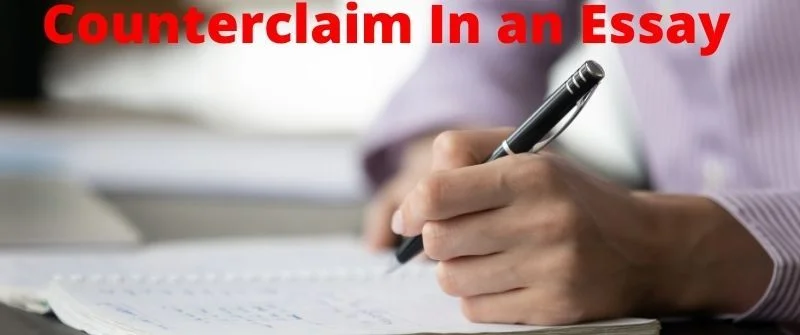
If you are writing an argumentative essay, you will find yourself including counterclaims. In this guide, we guide you on how to write a good counterclaim in an essay and how to frame your counterclaim sentence and paragraph in rebuttal.
Counterclaims are mostly included in an argumentative essay where you are required to convince your readers to agree with your arguments and point of view concerning the topic in question.
What is a Counterclaim in an Essay?
A counterclaim can be regarded as the argument or arguments that oppose the thesis statement in your essay. Within the introduction, you introduce the topic and create a thesis statement in the last sentence that makes it clear to your audience the point(s) you want to prove and the strategy you will use to prove it.
The counterclaim demonstrates to the reader that you have put into consideration the perspectives of the opposing side and you find such perspectives to be weak.
As such, a counterclaim will allow you to respond to the potential arguments of your readers before they complete reading the essay.
Additionally, a counterclaim demonstrates that both sides of the debate have been put into consideration, hence strengthening your position.
Difference Between a Claim and a Counterclaim
There is a big difference between a claim and a counterclaim. When writing essays, one may need to include both in the same essay, especially when presenting an argumentative topic.
The difference between a claim and a counterclaim lies in their assertion. A claim is a statement that demonstrates the position of argument or the assertion of a fact or a truth. On the other hand, a counterclaim is an argument that negates a specific claim by rebutting it. While a claim asserts the writer’s argument, a counterclaim rebuts.
When writing an essay, particularly an argumentative essay, you will have a topic and a thesis statement that will show the readers the points you are going to prove and how you will prove them.
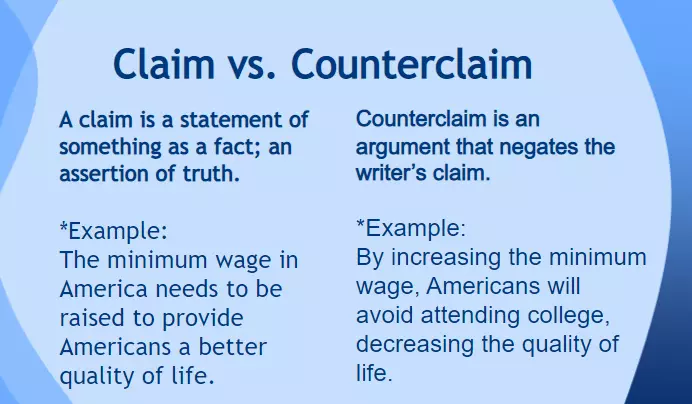
Most of your paper will be dedicated to proving your claim to the reader so that they can agree with your point of view.
A good claim should be arguable and at times controversial to allow the readers to think otherwise about your perspectives as the writer.
It can also come up with their interpretations concerning the topic.
Because of this, the essay will be based on the claim and you will demonstrate why your claim is accepted. On the other hand, a counterclaim is a statement of opposition that will allow the readers to perceive the whole picture of the arguments.
Though this is the case, the counterclaim demonstrates that the writer has anticipated arguments against their claim and has provided proof, through the counterclaim, that the readers’ perspectives are false or weak.
As such, when the counterclaim is stated, it is addressed concerning its weaknesses or limitations. This enhances the claim’s strength.
How to Write a Good Counterclaim in an Essay
If you wish to write a good counterclaim, make sure that it takes the form of two stages.

The first stage is where you go against your claim or argument so that you can challenge it and the second stage is where you turn back to your claim or argument to re-affirm it.
When writing a good counterclaim, you imagine that some of your readers will be skeptical and you have to make them agree with you.
For example, if you want to present a counterclaim showing that there was a problem with how you demonstrated your claims, like an unwarranted assumption, certain evidence was played down or ignored, and so on, you can support the counterclaim by presenting the disadvantages or drawbacks of the issues with the presentation. Then, give an alternative proposal or alternative that would make more sense to the readers.
To refute the counterclaim, you announce with words like ‘yet’, ‘but’, ‘however’, ‘still’, or ‘nevertheless’ to indicate that you are about to show why the counterclaim is wrong. Acknowledge that it is a good claim but demonstrate that yours might help the argument more.
Where to Write a Counterclaim in an Essay
A counterclaim can be included anywhere within the body of the essay except the conclusion. There are some cases where you can write a counterclaim at the second last sentence of the introduction paragraph followed by the thesis statement which acts as the refutation.
You can also write a counterargument after the introduction to show the anticipated reaction to your point of view before moving forward with writing your actual claims.
Moving forward, the reason why you cannot place the counterclaim within the conclusion is that you have to include a rebuttal paragraph or statements after you have written the counterclaim. Therefore, a counterclaim located at the conclusion will miss the rebuttal paragraph or statements.
However, argumentative essays can take different structures. Even though such essays will have a basic structure of an introduction, body paragraphs, and a conclusion, the differences will occur within the body paragraphs. Such differences dictate where the counterclaim(s) are located.
There is a structure where the counterclaims are located within all the body paragraphs. In this case, you will write your claim, followed by a counterclaim, and then a rebuttal. This means that for every claim you present to support your thesis, there will be a counterclaim and a rebuttal.
The most common structure is where you present your claims and present the counterclaim(s) before the conclusion. The counterclaim is immediately followed by a rebuttal.
Dos and Don’ts of Writing a Counterclaim
When it comes to the dos of writing a counterclaim, always ensure that it is followed by a rebuttal to demonstrate that your claims are superior to it. Secondly, courteously present your counterclaims to avoid upsetting the reader.

Acknowledge the anticipated arguments from the readers.
Demonstrate that the readers’ points of view are valid but your perspective makes more sense.
Finally, appeal to the logic of the readers through the use of valid evidence.
Concerning the don’ts when writing a counterclaim, do not include a counterargument just for the sake of it.
Make sure that the counterargument is valid in its own right and it is verifiable through evidence.
This is because your readers will also use logic and evidence when thinking about your claims. Secondly, do not use a disrespectful or uncourteous tone when addressing the other side of the argument.
Examples of Counterclaims
A counterclaim in a separate paragraph.
Counterclaim: “Opponents argue that after-school sports can increase the likelihood of sports-related injuries (Bancroft, 2018). Even minor injuries sustained from participation in after-school sports increase absent rates and the expense of creating injury reports for students (Sizemore, 2019)” .
Refutation: “Although students do suffer both serious and minor injuries in after-school sports, these injuries are quite rare (Kinney, 2016) .
Embedded Within a Paragraph
“Without free after-school sports programs, many students would still play sports without adult supervision and even more injuries would result”. Counterclaim : “However, some people would argue that after-school sports can increase the likelihood of sports-related injuries (Sizemore 2019)”. Refutation: “Although students do suffer both serious and minor injuries in after-school sports, without school-sponsored sports, the likelihood of more injuries from less supervised recreational leagues or privately sponsored leagues with fewer safety regulations would be much worse” .
How Long Should a Counterclaim Be?
A counterclaim can be as long as a paragraph if it appears after the introduction paragraph or at the end of the body before the conclusion. However, if a counterclaim is located within a paragraph, it can be a few sentences long (2-3).
However, the length of a counterclaim depends on the length of a claim in general. You can learn more about how to write a claim paragraph in that guide so that you can learn the two in general.
How many Counterclaims can you Put?
This depends on the structure of the essay. If the counterclaim appears after the introduction or before the conclusion, then it will only be one. However, if it is embedded within paragraphs, then they will be as many as the supportive augments.
This is because they will be used to refute every claim made within the body paragraph. If your supporting claims are 5 then the counterclaims will be 5 and so on.
Check out how to write college essays in our guide that we hope will lead you to score well.

Joseph is a freelance journalist and a part-time writer with a particular interest in the gig economy. He writes about schooling, college life, and changing trends in education. When not writing, Joseph is hiking or playing chess.
Thesis Helpers
Find the best tips and advice to improve your writing. Or, have a top expert write your paper.
How To Write a Counterclaim For Your Thesis Or Dissertation
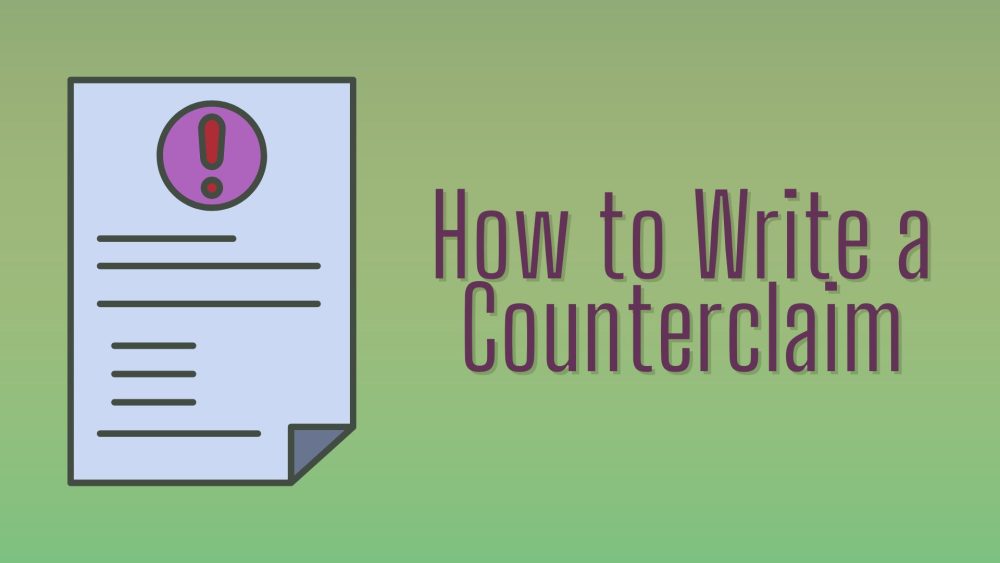
Are you writing an argumentative essay and want to score top grades? One of the things that you must do is to consider both sides of the central argument. It is true that the primary purpose of your argumentative paper is taking a side on the selected topic and supporting it as much as possible to persuade the reader to agree with your position. However, not bringing out a counterclaim/s is likely to make the reader, professor or class teacher consider you narrow-minded.
Despite its importance, how to write a counterclaim and rebuttal turns out to be a challenging undertaking for most students because it has to be done carefully to avoid weakening the main argument. So, how do you write a great counterclaim? Keep reading for a step-by-step guide on how to write a counterclaim paragraph like an expert.
Table of Contents
What is a counterclaim in writing, how to write a counter claim, how to start a counterclaim paragraph, good examples of a counterclaim paragraph, 8 expert tips for writing a great counterclaim.
Before making a counterclaim, it is prudent to ensure the thesis clearly demonstrates what your central argument is. Therefore, you should not include the counter claim in this section of the paper.
A counterclaim is included in argumentative writing to demonstrate to the reader that you have comprehensively researched both sides of the topic. It is very important to win over readers who might have a different point of view from that presented in the paper. Furthermore, a carefully presented counterargument can make your essay interesting and help you get more points compared to other students in class.
To write a great essay, you need to clearly bring out the main stand of your paper and bring it out vividly and then capture the counterarguments. The following four steps show how to write rebuttal for your essay like a pro.
- Step One: Research the Main Counterarguments for Your Thesis The first step is comprehensively researching your main points and counterarguments. As you dig deeper into counterarguments, try to establish why people disagree with your stand. If you are writing about the importance of addressing global warming right to address, what is driving the dissenting views? Is the alternative opinion based on facts?
- Write the counterclaim after highlighting the main thesis: Make sure that your stand on the essay is clear so that the reader can appreciate the difference with the dissenting views.
- Place the counterclaim in the paragraphs: If your essay has several arguments that require counterclaims, you can place them in the paragraphs. The best position is after highlighting the argument in every paragraph.
- Before the conclusion: This is the most preferred point for placing counterclaims. It works best because the university or college professor will have gone through the essay and a good counterclaim will demonstrate you did comprehensive research.
Next, put down the rebuttal. The rebuttal should be used to demonstrate why the counterargument is weak and, therefore, the thesis of the essay the best /option debate. When presenting the rebuttal, here are some suggestions:
- The main reason why the counterclaim is false or weak.
- Acknowledgment that the counter argument has some merit, but there is a reliable solution to the challenge. The solution can also demonstrate that the counterargument is baseless.
- Demonstrate that the benefits presented in the essay far outweigh the dangers of the counter arguments.
For most students, how to start a counterclaim is a big challenge, but we have the best suggestions. Target ensuring the contrast with the main argument of the essay is demonstrated well and the flow of key points is strengthened. So, here are some great examples of how to start a counter argument paragraph:
“The contrasting viewpoint indicates that …” “On the other edge of the argument, some researchers are concerned about …” “Critiques of this viewpoint suggest that …” “The opposing debate indicates that …”
Now that we have highlighted the best way to write a great counter claim for your essay, here are some examples.
Example One: Points Out the Weakness of the Counterarguments
Topic: The Dangers of Dams
Those of the contrasting views indicate that dams come with many benefits for both individuals and cities. For example, the water reservoirs help provide water for land irrigation, generate hydro-electricity, and stabilize water supplies. They see these as important attributes that warrant having dams in their location.
The risks that come with installing dams are, however, far too risky. Indeed, there are alternative solutions that we can use to avoid the threats from dams. Good examples are using green technology, such as solar panels, for energy generation and afforestation to not only stabilize water supply but also protect wildlife habitats. New technologies for water harvesting and storage can also help to guarantee communities reliable water supplies.
Example Two: Agrees with Counter Claim and Offer New Evidence to Counter It
Topic: Dangers of E-Cigarettes
Proponents of e-cigarettes argue that they do not cause major secondary pollution to other people in the vicinity because only water vapor is released into the atmosphere. They also insist that there is no carbon monoxide released into the air. Although this is true, the proponents fail to outline that e-cigarettes come with other very harmful elements that are released into the atmosphere.
Example Three: Notes Inconsistencies in Counterargument
Topic: The Benefits of After-School Sports
Critiques of after-school sports posit that it raises the danger of sports-related injuries. Such injuries, as brought out by Liam and Mathews (2009), can increase absenteeism. Although true because most sports come with some risks, the opponents fail to appreciate the huge benefits that come from after-school sports. Top sports people, from Thomas to Jeremy of the national soccer team, discovered their talents during after-school sports at an early age.
Finally, here are some tips to keep in my when writing your counterclaim for your thesis or essay. Also if you’re writing a full thesis don’t hesitate to get abstract writing services online once you need them.
- Always make your counter arguments as short as possible.
- Remain objective, especially with the language used in presenting the counterclaim. For example, you should avoid arguing that some researchers “erroneously hold the view that …” Instead, simply outline the counterclaim and give an alternative opinion.
- Avoid placing the counterargument on the conclusion because it requires a separate paragraph for rebuttal. This could easily distort the structure of the essay and the flow of ideas.
- Consider honing your skills in writing counterarguments by reading through other essays to see how experts did it.
- Make sure you are fair when presenting the counter claims. For a school essay, you might simply target throwing some verbal punches, but a college or university-level paper might require going into greater details. For example, you need to demonstrate why your argument is right and validate your arguments against those of the opposing school of thought.
- If your lecturer has a specific guideline or preference for writing the counter claims, make sure to follow it.
- Just like the main idea of your essay, the counterclaim should also be supported by proof gathered during research. However, ensure to demonstrate why it is weaker than the main argument presented in the essay.
- Proofread the essay after writing the counterclaim to ensure it is error-free, and all the points are flowing smoothly from the start to the end. You might want to ask a friend or professional writers to help with proofreading so that even the hidden mistakes are noted.
Seek Assistance Of Expert Writers To Write Your Argumentative Thesis
This guide has demonstrated the best strategies to use when writing a counterclaim in an essay. Remember that to get more points and stand out in class, you must focus on all areas of the essay, from the introduction and thesis statement writing to preparing counterclaim argument and conclusion. So, does the entire process appear challenging? Many students often get stuck when writing their essays and the best way out is to seek help from a writing service.
Students often get stuck because they have poor research and writing skills or the time is limited. For others, the whole concept of counterarguments, especially how to introduce a counterclaim, is too complex. However, we have creative writers at our writing service, and you can count on them to prepare A-rated papers. They have excellent essay writing skills, and no matter the topic of your argumentative essay; they guarantee the best results.
Our custom thesis help online is also affordable and easy to reach for all students. In addition to essays, our coursework and thesis writing service are excellent. Talk to customer support or visit our order page to get all the assistance you want.

Make PhD experience your own
Leave a Reply Cancel reply
Your email address will not be published. Required fields are marked *

Nathaniel Tower
Juggling writing and life
Understanding Claims in Writing and How to Craft Effective Ones
Last Updated on July 7, 2023 by Nathaniel Tower
In the realm of academic and persuasive writing, a claim holds significant importance. A claim serves as the central assertion or argument made by a writer to support their position or viewpoint. It is the backbone of an essay or any piece of writing, providing a clear focus and direction for the reader. Crafting a strong claim requires careful thought, analysis, and supporting evidence. In this article, we will delve into the concept of claims in writing and explore effective strategies for constructing compelling and persuasive claims.
What is a Claim?
A claim is a declarative statement that expresses the writer’s position or viewpoint on a particular subject. It is often referred to as a thesis statement or central argument. A well-crafted claim should be concise, specific, and debatable. It presents an opinion or interpretation that can be supported or challenged through logical reasoning and evidence.
Claims can take various forms, including factual claims that present verifiable information, value claims that express opinions about what is good or bad, and policy claims that propose specific courses of action. Regardless of the type, a claim should be formulated in a way that engages the reader and compels them to consider the writer’s perspective.
How to Write an Effective Claim
- Revise and Refine : Once you have drafted your claim, review and revise it to ensure clarity and effectiveness. Check for any logical fallacies, inconsistencies, or weak points in your argument. Seek feedback from peers or instructors to gain different perspectives and improve your claim.
What is a counterclaim in writing?
In writing, a counterclaim refers to a rebuttal or opposing argument presented by the writer to challenge or refute the main claim or thesis statement. It serves as a counterargument that acknowledges the opposing viewpoint and attempts to undermine its credibility or validity. A counterclaim adds depth and complexity to an argument by considering different perspectives and engaging in a more comprehensive analysis of the topic.
When constructing a counterclaim, it is essential to present a strong and logical argument that challenges the original claim. This entails conducting thorough research, gathering evidence, and providing convincing reasoning to support the counterargument. By doing so, the writer demonstrates their ability to critically evaluate multiple viewpoints and engage in a balanced discussion.
A well-crafted counterclaim should address the opposing side’s key points, highlight any weaknesses or fallacies in their argument, and provide a compelling alternative perspective. It is crucial to maintain a respectful tone and avoid personal attacks or derogatory language while presenting the counterclaim. Instead, focus on presenting a coherent and evidence-based argument that can effectively challenge the original claim.
In addition to presenting the counterclaim, it is essential to refute the opposing viewpoint by offering counter-evidence or providing a different interpretation of the existing evidence. This helps strengthen the writer’s position and credibility by demonstrating a comprehensive understanding of the topic and a willingness to engage with alternative perspectives.
By including a counterclaim in their writing, the author not only acknowledges the complexity of the issue but also shows a commitment to intellectual rigor and fairness. It encourages readers to consider multiple viewpoints, critically evaluate arguments, and arrive at a well-informed conclusion. In academic writing, including counterclaims demonstrates the writer’s ability to engage in scholarly discourse and contributes to the overall quality and credibility of the work.
Conclusion
Crafting a strong claim is essential for writing compelling and persuasive pieces. A well-constructed claim provides a clear focus and direction, engages the reader, and supports the writer’s position or viewpoint. By understanding the purpose of your writing, conducting thorough research, formulating a clear claim, providing evidence, and considering counterarguments, you can create a robust claim that strengthens your overall argument. Remember to revise and refine your claim to ensure its effectiveness. With a well-crafted claim, you can captivate your audience and present a convincing argument in your writing.

Share this:
- Click to share on Twitter (Opens in new window)
- Click to share on Facebook (Opens in new window)
- Click to share on LinkedIn (Opens in new window)
- Click to share on Pinterest (Opens in new window)
- Click to share on Reddit (Opens in new window)
Leave a Reply Cancel reply
Privacy overview.
Have a language expert improve your writing
Run a free plagiarism check in 10 minutes, generate accurate citations for free.
- Knowledge Base
- How to write an argumentative essay | Examples & tips
How to Write an Argumentative Essay | Examples & Tips
Published on July 24, 2020 by Jack Caulfield . Revised on July 23, 2023.
An argumentative essay expresses an extended argument for a particular thesis statement . The author takes a clearly defined stance on their subject and builds up an evidence-based case for it.
Instantly correct all language mistakes in your text
Upload your document to correct all your mistakes in minutes

Table of contents
When do you write an argumentative essay, approaches to argumentative essays, introducing your argument, the body: developing your argument, concluding your argument, other interesting articles, frequently asked questions about argumentative essays.
You might be assigned an argumentative essay as a writing exercise in high school or in a composition class. The prompt will often ask you to argue for one of two positions, and may include terms like “argue” or “argument.” It will frequently take the form of a question.
The prompt may also be more open-ended in terms of the possible arguments you could make.
Argumentative writing at college level
At university, the vast majority of essays or papers you write will involve some form of argumentation. For example, both rhetorical analysis and literary analysis essays involve making arguments about texts.
In this context, you won’t necessarily be told to write an argumentative essay—but making an evidence-based argument is an essential goal of most academic writing, and this should be your default approach unless you’re told otherwise.
Examples of argumentative essay prompts
At a university level, all the prompts below imply an argumentative essay as the appropriate response.
Your research should lead you to develop a specific position on the topic. The essay then argues for that position and aims to convince the reader by presenting your evidence, evaluation and analysis.
- Don’t just list all the effects you can think of.
- Do develop a focused argument about the overall effect and why it matters, backed up by evidence from sources.
- Don’t just provide a selection of data on the measures’ effectiveness.
- Do build up your own argument about which kinds of measures have been most or least effective, and why.
- Don’t just analyze a random selection of doppelgänger characters.
- Do form an argument about specific texts, comparing and contrasting how they express their thematic concerns through doppelgänger characters.

Receive feedback on language, structure, and formatting
Professional editors proofread and edit your paper by focusing on:
- Academic style
- Vague sentences
- Style consistency
See an example

An argumentative essay should be objective in its approach; your arguments should rely on logic and evidence, not on exaggeration or appeals to emotion.
There are many possible approaches to argumentative essays, but there are two common models that can help you start outlining your arguments: The Toulmin model and the Rogerian model.
Toulmin arguments
The Toulmin model consists of four steps, which may be repeated as many times as necessary for the argument:
- Make a claim
- Provide the grounds (evidence) for the claim
- Explain the warrant (how the grounds support the claim)
- Discuss possible rebuttals to the claim, identifying the limits of the argument and showing that you have considered alternative perspectives
The Toulmin model is a common approach in academic essays. You don’t have to use these specific terms (grounds, warrants, rebuttals), but establishing a clear connection between your claims and the evidence supporting them is crucial in an argumentative essay.
Say you’re making an argument about the effectiveness of workplace anti-discrimination measures. You might:
- Claim that unconscious bias training does not have the desired results, and resources would be better spent on other approaches
- Cite data to support your claim
- Explain how the data indicates that the method is ineffective
- Anticipate objections to your claim based on other data, indicating whether these objections are valid, and if not, why not.
Rogerian arguments
The Rogerian model also consists of four steps you might repeat throughout your essay:
- Discuss what the opposing position gets right and why people might hold this position
- Highlight the problems with this position
- Present your own position , showing how it addresses these problems
- Suggest a possible compromise —what elements of your position would proponents of the opposing position benefit from adopting?
This model builds up a clear picture of both sides of an argument and seeks a compromise. It is particularly useful when people tend to disagree strongly on the issue discussed, allowing you to approach opposing arguments in good faith.
Say you want to argue that the internet has had a positive impact on education. You might:
- Acknowledge that students rely too much on websites like Wikipedia
- Argue that teachers view Wikipedia as more unreliable than it really is
- Suggest that Wikipedia’s system of citations can actually teach students about referencing
- Suggest critical engagement with Wikipedia as a possible assignment for teachers who are skeptical of its usefulness.
You don’t necessarily have to pick one of these models—you may even use elements of both in different parts of your essay—but it’s worth considering them if you struggle to structure your arguments.
Regardless of which approach you take, your essay should always be structured using an introduction , a body , and a conclusion .
Like other academic essays, an argumentative essay begins with an introduction . The introduction serves to capture the reader’s interest, provide background information, present your thesis statement , and (in longer essays) to summarize the structure of the body.
Hover over different parts of the example below to see how a typical introduction works.
The spread of the internet has had a world-changing effect, not least on the world of education. The use of the internet in academic contexts is on the rise, and its role in learning is hotly debated. For many teachers who did not grow up with this technology, its effects seem alarming and potentially harmful. This concern, while understandable, is misguided. The negatives of internet use are outweighed by its critical benefits for students and educators—as a uniquely comprehensive and accessible information source; a means of exposure to and engagement with different perspectives; and a highly flexible learning environment.
The body of an argumentative essay is where you develop your arguments in detail. Here you’ll present evidence, analysis, and reasoning to convince the reader that your thesis statement is true.
In the standard five-paragraph format for short essays, the body takes up three of your five paragraphs. In longer essays, it will be more paragraphs, and might be divided into sections with headings.
Each paragraph covers its own topic, introduced with a topic sentence . Each of these topics must contribute to your overall argument; don’t include irrelevant information.
This example paragraph takes a Rogerian approach: It first acknowledges the merits of the opposing position and then highlights problems with that position.
Hover over different parts of the example to see how a body paragraph is constructed.
A common frustration for teachers is students’ use of Wikipedia as a source in their writing. Its prevalence among students is not exaggerated; a survey found that the vast majority of the students surveyed used Wikipedia (Head & Eisenberg, 2010). An article in The Guardian stresses a common objection to its use: “a reliance on Wikipedia can discourage students from engaging with genuine academic writing” (Coomer, 2013). Teachers are clearly not mistaken in viewing Wikipedia usage as ubiquitous among their students; but the claim that it discourages engagement with academic sources requires further investigation. This point is treated as self-evident by many teachers, but Wikipedia itself explicitly encourages students to look into other sources. Its articles often provide references to academic publications and include warning notes where citations are missing; the site’s own guidelines for research make clear that it should be used as a starting point, emphasizing that users should always “read the references and check whether they really do support what the article says” (“Wikipedia:Researching with Wikipedia,” 2020). Indeed, for many students, Wikipedia is their first encounter with the concepts of citation and referencing. The use of Wikipedia therefore has a positive side that merits deeper consideration than it often receives.
Prevent plagiarism. Run a free check.
An argumentative essay ends with a conclusion that summarizes and reflects on the arguments made in the body.
No new arguments or evidence appear here, but in longer essays you may discuss the strengths and weaknesses of your argument and suggest topics for future research. In all conclusions, you should stress the relevance and importance of your argument.
Hover over the following example to see the typical elements of a conclusion.
The internet has had a major positive impact on the world of education; occasional pitfalls aside, its value is evident in numerous applications. The future of teaching lies in the possibilities the internet opens up for communication, research, and interactivity. As the popularity of distance learning shows, students value the flexibility and accessibility offered by digital education, and educators should fully embrace these advantages. The internet’s dangers, real and imaginary, have been documented exhaustively by skeptics, but the internet is here to stay; it is time to focus seriously on its potential for good.
If you want to know more about AI tools , college essays , or fallacies make sure to check out some of our other articles with explanations and examples or go directly to our tools!
- Ad hominem fallacy
- Post hoc fallacy
- Appeal to authority fallacy
- False cause fallacy
- Sunk cost fallacy
College essays
- Choosing Essay Topic
- Write a College Essay
- Write a Diversity Essay
- College Essay Format & Structure
- Comparing and Contrasting in an Essay
(AI) Tools
- Grammar Checker
- Paraphrasing Tool
- Text Summarizer
- AI Detector
- Plagiarism Checker
- Citation Generator
An argumentative essay tends to be a longer essay involving independent research, and aims to make an original argument about a topic. Its thesis statement makes a contentious claim that must be supported in an objective, evidence-based way.
An expository essay also aims to be objective, but it doesn’t have to make an original argument. Rather, it aims to explain something (e.g., a process or idea) in a clear, concise way. Expository essays are often shorter assignments and rely less on research.
At college level, you must properly cite your sources in all essays , research papers , and other academic texts (except exams and in-class exercises).
Add a citation whenever you quote , paraphrase , or summarize information or ideas from a source. You should also give full source details in a bibliography or reference list at the end of your text.
The exact format of your citations depends on which citation style you are instructed to use. The most common styles are APA , MLA , and Chicago .
The majority of the essays written at university are some sort of argumentative essay . Unless otherwise specified, you can assume that the goal of any essay you’re asked to write is argumentative: To convince the reader of your position using evidence and reasoning.
In composition classes you might be given assignments that specifically test your ability to write an argumentative essay. Look out for prompts including instructions like “argue,” “assess,” or “discuss” to see if this is the goal.
Cite this Scribbr article
If you want to cite this source, you can copy and paste the citation or click the “Cite this Scribbr article” button to automatically add the citation to our free Citation Generator.
Caulfield, J. (2023, July 23). How to Write an Argumentative Essay | Examples & Tips. Scribbr. Retrieved April 1, 2024, from https://www.scribbr.com/academic-essay/argumentative-essay/
Is this article helpful?

Jack Caulfield
Other students also liked, how to write a thesis statement | 4 steps & examples, how to write topic sentences | 4 steps, examples & purpose, how to write an expository essay, what is your plagiarism score.
When you write an academic essay, you make an argument: you propose a thesis and offer some reasoning, using evidence, that suggests why the thesis is true. When you counter-argue, you consider a possible argument against your thesis or some aspect of your reasoning. This is a good way to test your ideas when drafting, while you still have time to revise them. And in the finished essay, it can be a persuasive and (in both senses of the word) disarming tactic. It allows you to anticipate doubts and pre-empt objections that a skeptical reader might have; it presents you as the kind of person who weighs alternatives before arguing for one, who confronts difficulties instead of sweeping them under the rug, who is more interested in discovering the truth than winning a point.
Not every objection is worth entertaining, of course, and you shouldn't include one just to include one. But some imagining of other views, or of resistance to one's own, occurs in most good essays. And instructors are glad to encounter counterargument in student papers, even if they haven't specifically asked for it.
The Turn Against
Counterargument in an essay has two stages: you turn against your argument to challenge it and then you turn back to re-affirm it. You first imagine a skeptical reader, or cite an actual source, who might resist your argument by pointing out
- a problem with your demonstration, e.g., that a different conclusion could be drawn from the same facts, a key assumption is unwarranted, a key term is used unfairly, certain evidence is ignored or played down;
- one or more disadvantages or practical drawbacks to what you propose;
- an alternative explanation or proposal that makes more sense.
You introduce this turn against with a phrase like One might object here that... or It might seem that... or It's true that... or Admittedly,... or Of course,... or with an anticipated challenging question: But how...? or But why...? or But isn't this just...? or But if this is so, what about...? Then you state the case against yourself as briefly but as clearly and forcefully as you can, pointing to evidence where possible. (An obviously feeble or perfunctory counterargument does more harm than good.)
The Turn Back
Your return to your own argument—which you announce with a but, yet, however, nevertheless or still —must likewise involve careful reasoning, not a flippant (or nervous) dismissal. In reasoning about the proposed counterargument, you may
- refute it, showing why it is mistaken—an apparent but not real problem;
- acknowledge its validity or plausibility, but suggest why on balance it's relatively less important or less likely than what you propose, and thus doesn't overturn it;
- concede its force and complicate your idea accordingly—restate your thesis in a more exact, qualified, or nuanced way that takes account of the objection, or start a new section in which you consider your topic in light of it. This will work if the counterargument concerns only an aspect of your argument; if it undermines your whole case, you need a new thesis.
Where to Put a Counterargument
Counterargument can appear anywhere in the essay, but it most commonly appears
- as part of your introduction—before you propose your thesis—where the existence of a different view is the motive for your essay, the reason it needs writing;
- as a section or paragraph just after your introduction, in which you lay out the expected reaction or standard position before turning away to develop your own;
- as a quick move within a paragraph, where you imagine a counterargument not to your main idea but to the sub-idea that the paragraph is arguing or is about to argue;
- as a section or paragraph just before the conclusion of your essay, in which you imagine what someone might object to what you have argued.
But watch that you don't overdo it. A turn into counterargument here and there will sharpen and energize your essay, but too many such turns will have the reverse effect by obscuring your main idea or suggesting that you're ambivalent.
Counterargument in Pre-Writing and Revising
Good thinking constantly questions itself, as Socrates observed long ago. But at some point in the process of composing an essay, you need to switch off the questioning in your head and make a case. Having such an inner conversation during the drafting stage, however, can help you settle on a case worth making. As you consider possible theses and begin to work on your draft, ask yourself how an intelligent person might plausibly disagree with you or see matters differently. When you can imagine an intelligent disagreement, you have an arguable idea.
And, of course, the disagreeing reader doesn't need to be in your head: if, as you're starting work on an essay, you ask a few people around you what they think of topic X (or of your idea about X) and keep alert for uncongenial remarks in class discussion and in assigned readings, you'll encounter a useful disagreement somewhere. Awareness of this disagreement, however you use it in your essay, will force you to sharpen your own thinking as you compose. If you come to find the counterargument truer than your thesis, consider making it your thesis and turning your original thesis into a counterargument. If you manage to draft an essay without imagining a counterargument, make yourself imagine one before you revise and see if you can integrate it.
Gordon Harvey (adapted from The Academic Essay: A Brief Anatomy), for the Writing Center at Harvard University
- Elephango for Families
- Elephango for Schools
- Standards Search
- Family Sign-Up
Argument Writing 101: Counterclaims
Contributor: Dru Cartier. Lesson ID: 13729
Supporting evidence, counterclaims, and rebuttals! Oh my! Learn how to strengthen your argument in just a few steps.
Literary Studies, Writing
Lesson plan - get it.
- Have you ever tried to convince a friend to like something you like or to think the way you think?
Perhaps you LOVE taco pizza and want your friends to love it too. They'll probably want a good reason to try it.
By the end of this lesson, you will be able to convince them to love it just as much as you do!

- How will you convince them though?
Let's start with three essential questions.

- What makes an argument effective?

- Why does making an argument matter?

- How does counterevidence help you make your claim?
By the end of this lesson, you will be able to convince your friends to love taco pizza as much as you!
Let's start by exploring a written arugment on e-readers.
First, read The case against e-readers: Why reading paper books is better for your mind. by Naomi S. Baron for The Washington Post .
[This website does require a subscription to access articles. If you do not have one, please access a copy of the article under the Downloadable Resources in the right-hand sidebar.]
The title of this article is also its claim: the case against e-readers. However, it actually starts by talking about how great they are.
- Coincidence?
Think again.
- What are three reasons, or counterclaims, the author gives to love e-readers?
- What are three rebuttals, or supporting claims, the author gives against e-readers?
If you notice, each counterclaim has a matching rebuttal.
For example, the article states e-readers are environmentally friendly because they do not harm trees, yet the rebuttal states the manufacturing of the e-readers does more harm than good.
It mentions that e-readers provide more access to books for all people; however, there are many people who cannot use e-readers either because they don't have internet access or perhaps they have issues looking at screens too long.
Another counterclaim described the convenience of e-readers, while the rebuttal stated they can hurt the person's concentration because the devices also provide access to the internet.
By starting the article with the potential counterclaims your opposition might use, you are able to redirect how the argument goes. You not only keep control of the argument, but you show that you know the topic really well and are not hiding anything. It gives you credibility.
Now you know what the parts of a strong argument are:
- the claim (a statement you are prepared to defend)
- the counterclaim (supporting evidence against your claim)
- the rebuttal (the evidence that supports your claim)
You are halfway to becoming an argument master!

- Are you ready to check out the Got It? section?

Resources and Extras
- pencil or pen
- argument partner (optional)
- The case against e-readers: Why reading paper books is better for your mind.
Related Badges

Let's Get Logical

Art of Arguing
Suggested lessons.

Be a Super Summarizer

Two Texts with the Same Topic: Let's Compare!

Authors Write; Illustrators Draw!
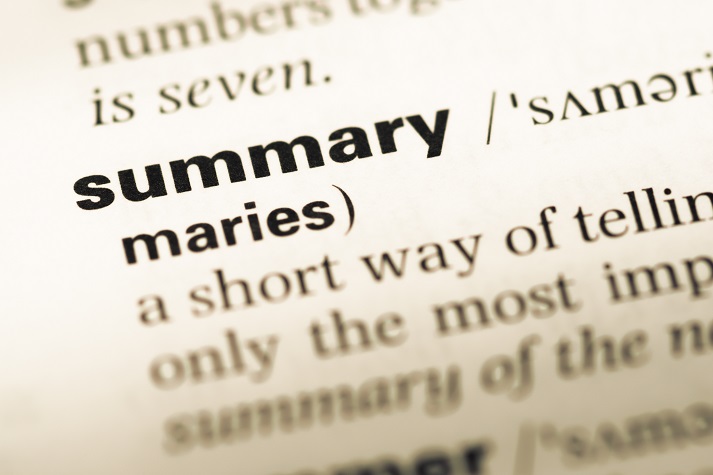
Citing Summary from a Source in MLA Format
- Skip to primary navigation
- Skip to main content
- Skip to primary sidebar
- Skip to footer

Dianna Radcliff
Teaching Upper Elementary & more
How to Teach Claims, Counterclaims and Rebuttals in Writing!
July 29, 2019 by Dianna Radcliff

Teaching claims, counterclaims and rebuttals in writing can improve a students opinion or argumentative essay.
This post will explain how I teach claims, counterclaims and rebuttals in writing.
To begin, let’s clarify the meaning of the following terms when giving instruction:
- Counterclaim

What is a Counterclaim?
A counterclaim is a claim used to rebut a previous claim.
A claim is the main argument. A counterclaim is the opposite of the claim, or argument.
What is a Rebuttal?
A rebuttal is when you address and challenge a claim by disapproving it.
After you have stated your counterclaim in an argument, you add your rebuttal to why you disapprove it. The goal is to weaken the main argument with your reasons and evidence.
What is a Reason?
A reason tells why a claim is made. Followed by supporting evidence.
What is Evidence?
Evidence is the facts or research to support the claim and reason.
Mini Lesson:
What to Prepare in advance:
- Download, print, cut, laminate and attach to sticks the FREE resource below.
- Write or type examples of a claim, counterclaim and rebuttal then cut up. This is for the acting out part. (see image below as an example)
- Find additional examples via student work pieces, articles or in texts to share and color code. You can share on another anchor chart, display on your SmartBoard or simply read aloud.

- Introduce the lesson by creating an anchor chart. (See below example or search online.)
- Using the colors in my example below, or your own colors, share examples from student pieces, articles or in texts you have found. You can share these examples on another anchor chart, display on your SmartBoard or simply read aloud.
- Using the stick bubbles in the FREE resource below, have 3 volunteers come up to demonstrate. Line students up in order and have them read their part holding up the stick bubble when speaking.

Anchor Chart Examples:
***Click on the Anchor Chart images to find more anchor charts you can use in your classroom!

Where to insert a Counterclaim?
When modeling, show students examples of inserting a counterclaim inside a body paragraph following reasons and evidence.
Where to insert a Rebuttal?
When modeling, show students examples of inserting a rebuttal following a counterclaim inside a body paragraph. Always use reasons and evidence.
Free Resource to Download:
More Helpful Essay Writing Resources:
- FREE Essay Planning Pages
- FREE Paragraph Writing Rubric
- FREE Paragraph Writing for an Essay Graphic Organizers (Color Coded)
- FREE Essay Writing Timing Slides
- Essay Writing Test Prep PowerPoint
- Essay Writing Sources and Prompts
***Click HERE or on the photo below to Download your FREE Resource! Simply print on colored paper (or cardstock) and then laminate!
Thank you for subscribing!

Share this:


Claim, Counterclaim, and Rebuttal
Please log in to save materials. Log in
- EPUB 3 Student View
- PDF Student View
- Thin Common Cartridge
- Thin Common Cartridge Student View
- SCORM Package
- SCORM Package Student View
- 1 - Lesson Plan
- View all as one page

Lesson Plan

LESSON DESCRIPTION
Claims and counterclaims.
Author of the Lesson: Eric Lougee
Lesson Summary/Overview: Students will be able to write counterclaims and rebuttals.
LESSON GOALS AND OBJECTIVES
Alignment and objectives.
Content Standards: OR.ELA.9-10.W.1 and OR.ELA.11-12.W.1
ELP Standards: ELP.9-12.4
An ELL can construct grade-appropriate oral and written claims and support them with reasoning and evidence.
Language (ELP) Objectives: Students will be able to write counterclaims and rebuttals.
Supporting Academic Language
Language Functions: Argumentation
Language Modalities: Writing
Vocabulary: claim, counterclaim, rebuttal, argument, evidence
Syntax or Sentence Structure(s):
A common argument against the position is _______________.
The opposing view is __________________________.
Others may believe that __________________.
There is some support for the idea that _____________________.
Despite this information, evidence shows that ___________________________________.
Nevertheless, evidence proves that_____________________________.
However, there is information that suggests ___________________________.
Discourse: Sports/Health
LESSON PREPARATION
Considerations.
Prerequisite Knowledge and Skills: Sharing an opinion, making a claim, finding evidence
Instructional Materials
Resources, Materials, and Technology required or recommended for the lesson: Sentence stips with example claims, counterclaims, and rebuttals. These could be teacher or student written.
Article: The Pros and Cons of Youth Sports Aren't Only Physical ( English version; Spanish version )
Graphic Organizer
Learning Supports
Socio-emotional supports: Chunking of material to provide breaks for students. Assign students to specific “jobs” during the lesson or when working in pairs.
Cultural & Linguistic Responsiveness: Provide pros and cons articles in Spanish. Use universally common topics when discussing claims, counterclaims, and rebuttals.
Accessibility: Article can be provided digitally and print.
Instructional Supports
Differentiation: strategic partnering, choice of sentence frames
L1 Supports: Sentence frames, strategic partnering
L2 Development (by level): Spanish translation of pros and cons article
LESSON PROCEDURES
Anticipatory set/motivation/hook.
Time: 10 mins
Teacher Does/Students Do: Teacher will hand out slips of paper to each student with either a claim, counterclaim, or rebuttal. There will be one of each that corresponds together. Example- Claim: Cell Phones should be allowed in the classroom. Counterclaim: Cell Phones should not be allowed in the classroom. Rebuttal: By allowing cell phone use in the classroom, students learn how to use and manage their cell phones as a digital resource as they should outside of school. Students must find the other students in the class that have matching claims, counterclaims, or rebuttals. Groups will share out loud to class their set of arguments.
Focused Instruction (Teacher-as-Model)
Time: 20 mins
Teacher Does/Students Do: Teacher will create an anchor chart of possible counterclaim sentence starters and rebuttal sentence starters. Teacher will model creating counterclaim sentences and rebuttal sentences.
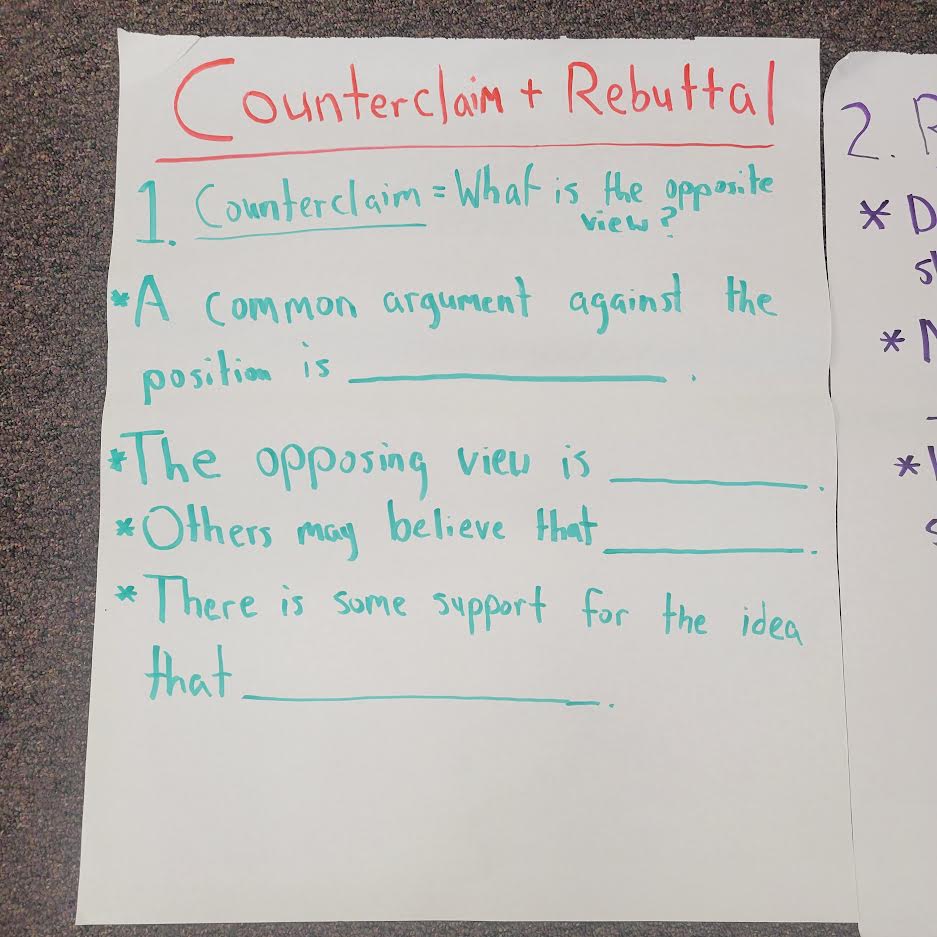
Guided Instruction (Teacher-to-Student Joint Responsibility)
Time: 5-10 mins
Teacher Does/Students Do: Teacher will select a claim from the prepared sentence strips. Together the class and teacher will create model counterclaim sentences and model rebuttal sentences.
Group Application (Student-to-Student Joint Responsibility)
Teacher Does/Students Do: Teacher will divide students into pairs and continue to select sentence strips with claims. In pairs, the students will work together to create a counterclaim and rebuttal for each of the selected claims.
Individual Learning (Independent Practice and Application)
Teacher Does/Students Do: Teacher will hand out the article “The Pros and Cons of Youth Sports Aren't Only Physical” to students. You could use another article of teacher or students’ choice that presents pros and cons of a topic. Use text to speech with digital copy as needed. ( English version; Spanish version )
Students will read the article. As they will fill out the graphic organizer with pros and cons. After filling out the graphic organizer. Students will write a claim, counterclaim, and rebuttal for each side of the question: Are sports good for students’ mental/psychological health?
Time: 5 mins
Teacher Does/Students Do: Students will share a counterclaim and a rebuttal that they developed from the article with a partner in the class.
ASSESSMENTS
Formative assessment.
Content & Language: Group/partner practice with sentence strips.
Students will be able to effectively give a logical counterclaim and rebuttal using the provided sentence frames.
Plans for Summative Assessments
Content & Language: Graphic Organizer
Ideas for Key Assignments, Extensions, and Adaptations for Online Learning Environments: Research a controversial topic. Prepare claims, counterclaims, and rebuttals for a debate.
- Words with Friends Cheat
- Wordle Solver
- Word Unscrambler
- Scrabble Dictionary
- Anagram Solver
- Wordscapes Answers
Make Our Dictionary Yours
Sign up for our weekly newsletters and get:
- Grammar and writing tips
- Fun language articles
- #WordOfTheDay and quizzes
By signing in, you agree to our Terms and Conditions and Privacy Policy .
We'll see you in your inbox soon.
What Is a Claim in Writing? Examples of Argumentative Statements

- DESCRIPTION argumentative statements of claim and counterclaim examples
- SOURCE Created by Lindy Gaskill for YourDictionary
- PERMISSION Copyright YourDictionary, Owned by YourDictionary
Are you wondering, "What is a claim in writing?" When you make an argument in writing and back it up with supporting evidence, you are making a claim. Claims are very common in research papers and certain types of essays.
Making Claims in Writing
Making a claim in your writing allows you to present the main idea of the document in the form of an argument that you will support with evidence throughout the document. A claim statement is a type of thesis statement in which you present the main idea of what you are writing in the form of an argument. Think of claims like a thesis statement in the form of an argument.
- Claims are matters of opinion, but they are stated as if they are facts and backed up with evidence.
- Any time you make a debatable statement in writing that is backed up with facts and/or other types of evidence, you are using a claim.
Statement vs. Claim Example
Argumentative claims don't have to be complex, but they do have to be more than just a fact-based statement that is obviously true. Instead, claims should be statements that are up for debate. As a writer, your goal is to effectively argue in favor of your claim. Review the examples below to develop a better understanding of what is a claim in an essay.
- statement - If you open an essay by stating, "I own a cell phone," this is not an example of a claim in writing. Assuming that you do, in fact, own a cell phone, this is just a statement of fact. It is not something that is arguable.
- claim - If you open by stating, "Every middle school student should have their own cell phone," this is a claim. This is not something that everyone agrees upon. Your paper will need to focus on supporting this claim with evidence.
Types of Writing That Use Claims
Claims are common in different types of writing, including documents created for school assignments or in the professional world.
- argumentative essays - These essays focus on an issue that is controversial, presenting evidence that backs up the writer's claim.
- research papers - Academic research papers are designed specifically to provide evidence to confirm or refute the writer's hypothesis , which is a type of claim.
- literary analysis - When engaged in literary analysis, writers make a claim about a literary work, then provide evidence from it to support their claim.
- persuasive essays - Persuasive essays are a type of argumentative essay. They use fact-based information as evidence to back up a writer's claim.
- persuasive speeches - Persuasive speeches are presented orally, but many start with an outline focused on providing evidence for a primary claim.
- persuasive memos - Persuasive memos are often designed to convince readers to believe or act on a claim backed up by evidence.
What Is Evidence in Writing?
In order to back up a claim in writing, you will need to provide evidence. Evidence is information that provides proof of or support for an idea. Your claim statement should be a logical conclusion that you reached as a result of reviewing and understanding valid, reliable evidence. Rather than expecting readers to simply believe that your claim is true, you'll need to provide them with evidence they can consider to reach their own conclusion.
There are many types of evidence:
- direct observation of a phenomenon or occurrence
- primary research, such as an experiment or content analysis
- synthesis of secondary research, such as a literature review
- information gathered from investigative interviews
- facts, statistics or other data
- expert opinions
- examples of past behavior
It's important to be aware that the fact you can find evidence in favor of your claim does not necessarily mean that your claim is a factual statement. There is also just as much evidence against a claim as there is evidence for them. The idea of making a claim in writing is to present a logical, fact-based argument for the claim that you are making.
Argumentative Claim Examples
Review a few examples of argumentative claims to help clarify what is a claim in writing. These examples can help you identify claims when reading works of writing, as well as provide you with inspiration when you need to write a claim statement.
- College students today should focus on learning skills that will qualify them to work effectively in a virtual environment.
- School uniforms help promote an inclusive educational environment for all students, regardless of socioeconomic status.
- In light of the severity of recent hurricanes, living near the coast is becoming increasingly hazardous.
- Yoga provides both physical and mental health benefits.
- Concrete is the best building material for residential structures.
- Children under the age of 12 should not be allowed to have social media profiles.
- Spending more than an hour per day on housework is a waste of time.
- People who get at least 10,000 steps per day are healthier than those who don't.
- Eating too many carbohydrates is the primary reason some people are overweight.
- Dining in restaurants is actually more economical for individuals or couples than cooking at home.
Note that the statements above are not commonly accepted facts. You may agree with some of these, but chances are that you don't agree with all of them. Each example above is a matter of opinion. If you write about any of these, you will need to back up with evidence in an effort to prove your point. Readers will decide whether or not they agree with your argument base on how effectively you make your point, as well as their own knowledge and/or opinion about the topic.
What to Include in a Claim Paragraph
An argumentative claim will generally appear in the first paragraph of a document. The claim statement is usually paired with a hook to form the introductory paragraph of an essay or other document. The hook is designed to capture reader interest so they will want to learn more, while the claim statement lets them know what point will be argued in the paper.
What Is a Counterclaim in Writing?
When someone presents an alternative argument to your claim, that is a counterclaim. Another word for a counterclaim is a rebuttal. When someone presents a counterclaim, they are making a claim of their own. It will be up to them to state their counterclaim, then seek to back it up with evidence (just as you did when making the initial claim).
- claim - making an argument and backing it up with evidence
- counterclaim - presenting a rebuttal to a claim and backing it up with evidence
Debates involve claims (arguments) and counterclaims (rebuttals). When people participate in a debate, they prepare arguments for their claims and deliver strong rebuttals to the claims of their opponents.
Explore Argumentation and Debate
Now that you know what a claim is in writing, consider taking a deeper dive into how this communication strategy can be used in writing and face-to-face communication. Start by exploring key ways the terms argument and debate differ . From there, investigate how examples of rhetoric can be used as a tool to persuade and motivate.
What Is a Claim in Writing? Definition, Types, & Examples
- February 20, 2024
- Freelancing Tips
Table of Contents Hide
What is a claim in writing, claim of fact, claim of value, claim of policy, types of writing with claims, examples of claims in writing, what is the difference between claims, opinions and facts, why do we use claims in writing, what is a counterclaim in writing, faqs on claim in writing, we also recommend.
When it comes to writing, making a claim is a crucial aspect of building a strong argument. But what exactly is a claim? Essentially, a claim is a statement that asserts a particular point or position on a specific topic. Claims serve as the foundation for persuasive writing and are essential for effectively making your case to your audience.
Understanding the different types of claims and how to effectively use them can greatly enhance the persuasiveness of your writing. Whether you are writing an essay, a research paper, or a persuasive speech, knowing how to craft strong claims is key to convincing your audience of your point of view.
In this article, we will explore the definition of a claim in writing, the various types of claims you can make, and provide examples to help you better understand how claims function in different contexts. By mastering the art of making compelling claims, you can elevate the quality of your writing and make a more convincing argument every time.
A claim in writing is the core argument defining an essay’s goal and direction. It’s assertive, debatable, and supported by evidence. Also, it is complex, specific, and detailed.
Think of a claim as a specific, debatable statement you, the writer, intend to prove or support. It’s the central argument in your essay, the core message of your blog post , and the foundation of your persuasive pitch. Unlike opinions, which are subjective beliefs without the burden of proof, claims demand justification. They’re the battle cry, the call to action, inviting your reader to join you on a quest for understanding and agreement.
READ ALSO: What Is Speech Writing? Best Tips And Jobs In 2024
What Are The Types Of Claims In Writing?
There are three types of claims: claims of fact, claims of value, and claims of policy . Each type of claim focuses on a different aspect of a topic. To best participate in an argument, it is beneficial to understand the type of claim that is being argued.
A claim of fact declares the existence, current presence, or future occurrence of something measurable. The core issue within a factual claim revolves around the reasonableness of the stated fact. To put it differently, a claim of fact engages in a discussion about the accuracy or inaccuracy, validity or invalidity, truth or falsehood of the statement. When making such assertions, our reasoning typically progresses from the known to the unknown. Claims of fact also center on examining cause-and-effect relationships.
SEE ALSO: What Is Speech Writing? Best Tips And Jobs In 2024
A claim of value makes qualitative assessments of people, things, and events in one’s surroundings on a good-to-bad continuum. You have made a valuable claim if you formulate an opinion that says something is good, terrible, or superior to another. Claims of worth include things like “Indian food is the best food of all,” “The Wizard of Oz is the greatest movie of all time,” and “Snowboarding is the greatest way to spend a vacation.”
A claim of policy makes the assertion that someone should or shouldn’t do a certain action. It suggests that a certain course of action ought to be followed, however, it’s not a given that it will. The conditional verb “should,” which indicates that a certain action ought to be taken but not that it must or will be taken, is crucial when making a claim about policy. For example, “Students should read the assigned text material before the instructor lectures on it,” or “The United States should send a manned expedition to Mars.”
Here’s a list of the types of writing with claims:
- Argumentative articles. Consider a controversial issue, proving it with evidence throughout your paper.
- Literary analysis. Build a claim about a book, and use evidence from it to support your claim.
- Research papers. Present a hypothesis and provide evidence to confirm or refute it.
- Speeches. State a claim and persuade the audience that you’re right.
- Persuasive essays and memos. State a thesis and use fact-based evidence to back it up..
What can you use as evidence in essays?
- Facts and other data from relevant and respectful resources (no Wikipedia or other sources like this)
- Primary research
- Secondary research (science magazines’ articles, literature reviews, etc.)
- Personal observation
- Expert quotes (opinions)
- Info from expert interviews
SEE ALSO: Tips On How To Hire Legal Writers In 2024
Here’s a rundown of examples of claims based on types:
Here’s how claims differentiate themselves from their close cousins:
- Opinions: These are personal beliefs, unsupported by evidence. Saying “Pizza is the best food ever” is an opinion, not a claim.
- Facts: These are verifiable truths, independent of interpretation. “The Earth revolves around the Sun” is a fact, not a claim.
- Claims: These are debatable propositions that require evidence to be convincing. “Eating spicy food boosts metabolism” is a claim, as it needs proof to be accepted.
All forms of writing rely on claims to maintain the interest of the reader, give characters more nuance and depth, and convey the author’s own viewpoint on the issues covered.
The objective of a claim in writing is to persuade the reader of anything. Claims drive the reader towards a specific solution, even when they may not agree with the author’s statement at first or may need more information to come to their own opinion. If a reader already concurs with an author’s assertion, the material offered just strengthens and validates the reader’s position.
Have you signed up on WritersGig? Check out How to Register as a Buyer or Writer on WritersGig
When someone presents an alternative argument to your claim, that is a counterclaim. Another word for a counterclaim is a rebuttal. When someone presents a counterclaim, they are making a claim of their own. It will be up to them to state their counterclaim, and then seek to back it up with evidence (just as you did when making the initial claim).
A claim is a statement that asserts a particular stance or viewpoint, while an opinion is a subjective expression of personal beliefs or preferences.
Make your claims more persuasive by providing clear evidence, avoiding overgeneralization, and addressing potential counterarguments.
Writers should be cautious when making claims without sufficient evidence or in areas where the topic is highly subjective and lacks objectivity.
It depends on the nature of the evidence and the claims. In some cases, a well-supported piece of evidence may contribute to multiple related claims.
Claims in writing showcase the diverse ways in which writers express their perspectives and influence their audience. Whether rooted in facts, values, or policies, claims form the bedrock of effective communication. Crafting and evaluating claims require a thoughtful approach, ensuring that writers engage their readers with clarity, evidence, and nuance.
- 15 Different Types of Tones in Writing: Must-Know Guide for All Writers
- 25 Inspiring Freelance Writing Quotes
- Types Of Freelance Writing | Descriptions And Jobs
- What Is A Contraction In Writing? Definition, How To Use, and Examples
Related Posts
When to use then and than: a quick guide to getting it right.
- March 30, 2024
50+ Opinion Writing Prompt Ideas for Better AI Writing
- March 28, 2024
When To Use A Semicolon vs Colon: Breaking Down Semicolons vs. Colons In Everyday Writing
Legal Dictionary
The Law Dictionary for Everyone
Counterclaim
There are two sides to every argument: (1) the “claim,” and (2) the “counterclaim.” The first is a statement of the party’s point, or argument for something. The second is a rebuttal , or argument opposing the claim. Once the parties have made their claims and counterclaims, they introduce the reasoning behind their arguments, and present evidence to support those claims. The claim/counterclaim system is used to make points in everything from essays and scientific papers, to litigation . To explore this concept, consider the following counterclaim definition.
Definition of Counterclaim
- A claim made to offset another claim in a legal action.
- To assert a claim for relief against a party who has made an original claim.
1775-1785 English (counter +claim)
What is Counterclaim
In very simple terms, a counterclaim is the opposite of a claim. In the legal system, once a person (the “ plaintiff ”) has filed a legal action, which makes certain claims against the other party (the “ defendant ”), the defendant must file an answer to the claims with the court. Once this has been done, the process of each party proving his own position begins. The counterclaim is just one of the four elements of an argument, which include:
- Claim – to assert facts that give rise to a legally enforceable right or judicial action
- Counterclaim – a claim for relief made in opposition to, or to offset another person’s claim
- Reasons – the rationale behind a party’s claim
- Evidence – something that proves the truth of a claim, or leads to a conclusion
Counterclaim Example
Marsha is a busy design consultant for a home décor and renovation company. Her job frequently takes her out of the office to visit clients’ homes and offices to formulate a redecoration plan, personally pick out supplies, and to personally check up on the construction or installation. Marsha’s phone is constantly ringing, as she fields phone calls throughout the day, regardless of her location. Marsha desperately wants to separate her stressful job from her personal life, so she tells her employer, Ralph, that she needs a company cell phone. Ralph, thinking only of the additional expense, simply says “No.”
Marsha has made her claim – asking for a company cell phone.
Ralph has made his counterclaim – responding in the negative.
Now Jane must offer substantial and valid reasons to convince Ralph that she needs the company to provide her with a company phone. Jane might provide evidence of the hardship using her personal phone is causing her and her family. Jane’s reasoning may include a description of how often clients call her phone when she is at her daughter’s soccer games on Saturdays, when she is sitting down to dinner with her family, or when she is out on “date night” with her husband.
Jane may point out that she receives so many business phone calls that she has had to record a business-like greeting for her voicemail, which confuses friends and family, who think they have called her “at work” by mistake. As evidence, Jane may give Ralph copies of her cell phone activity for the past couple of months, highlighting the many business calls she has received and made.
In this example of counterclaim, Ralph now needs to support his refusal to provide Jane with a company phone. He should be ready to give good, substantiated reasons for his refusal to provide something that the company should have been paying for all along. This may include evidence of the company’s inability to foot the bill, and that the company does not require Jane to take calls on her personal phone.
Compulsory Counterclaims and Permissive Counterclaims
Once a party has filed a civil lawsuit , the defending party may file a counterclaim against him. Such a claim is aimed directly at the plaintiff for coexisting damages or claims in the same matter, which may serve to lessen the defendant’s liability . Some states have attempted to consolidate related matters by requiring that a defendant file a counterclaim on any issue directly related to the original lawsuit. This is a compulsory counterclaim , as the defendant is required to bring up any issues that may counter the plaintiff’s claim, as part of the same lawsuit. If he fails to do so, he cannot make that claim later in a separate lawsuit.
For instance, the Federal Rules of Civil Procedure , Title III, Rule 13 , compels a compulsory counterclaim if:
(a) (1) … A pleading must state as a counterclaim any claim that—at the time of its service—the pleader has against an opposing party if the claim:
(A) arises out of the transaction or occurrence that is the subject matter of the opposing party’s claim; and
(B) does not require adding another party over whom the court cannot acquire jurisdiction .
A permissive counterclaim is instituted by a defendant against a plaintiff in a lawsuit, but the defendant’s claim does not arise from the same issue or transaction as the plaintiff’s original claim. Many states allow permissive counterclaims, depending on the subject matter, and how it relates to the original lawsuit. While a defendant is not required to bring up such issues during the current case, as would be the case in a compulsory counterclaim, if he does, and the issue is decided by the court as part of the lawsuit ruling, the defendant cannot bring that claim later in another lawsuit.
Example of Compulsory Counterclaim
Martin convinces his friend, Adam, to invest in his new ice cream truck business. The two enter into a written contract, which specifies that Adam will put in an initial investment of $5,000, and that Martin will do all of the work in obtaining an ice cream truck and inventory, and that he will work the truck. Adam agreed to pay another $5,000 in four months’ time to help ensure the business is well-funded in its early months. Sixty days after Adam paid Martin the initial $5,000, he discovered that Martin hadn’t purchased the truck or inventory like he was supposed to do, yet the money has been spent. As a result, Adam backs out, refusing to pay any more money.
Martin files a lawsuit in small claims court, asking the court to order Adam to pay the remaining $5,000 required by the contract. At trial , Adam argues that Martin hadn’t done the things he was supposed to do according to the business plan, and he suspected he didn’t intend to, which is the reason he had backed out of the deal. The judge rules in Martin’s favor, because the two had a written contract, and Adam hadn’t proven that Martin would not, or could not, accomplish all of the necessary tasks for the business. Adam is ordered to pay Martin the remaining $5,000, and the contract is to remain in full force and effect.
Once Martin had filed his lawsuit, Adam could have filed a counterclaim, claiming that Martin had fraudulently convinced him to invest the money, and asking for his $5,000 investment to be returned. This counterclaim then requires Martin to show to the court that he had indeed been fulfilling his responsibilities according to the contract, and that he will continue to do so. In such a case, the court will hear the entire case, from both sides, before making its decision.
A ruling in this example of counterclaim will likely balance the liability between both sides, with a net judgment being rendered. For instance, if the court determines that Adam does indeed have to pay the other $5,000, but that Martin had falsely inflated the amount of money needed in order to trick Adam into giving him $2,000 more than the business required, Adam may be ordered to pay Martin only $3,000.
If the pair lived in a state of compulsory counterclaim, Adam would be required to make this claim within a certain period of time after Martin had filed the lawsuit. If he failed to do so, he could not later file a lawsuit claiming Martin had fraudulently induced him into the contract.
Frivolous Counterclaim Rejected by Court
In 2013, three limited partners of a failed real estate venture filed a civil lawsuit against the general partners, who controlled the company. The plaintiffs accused the general partners of mishandling the business, causing the loss of their $1.9 million investment. Shortly after this lawsuit was filed in a New Jersey court, the defendant managing partners filed a counterclaim, suing the limited partners for breach of fiduciary duty , waste of corporate funds, and violation of the covenant of good faith and fair dealings.
The plaintiff partners immediately realized that the counterclaim was a thinly veiled attempt to manipulate and restrict settlement efforts, and filed a motion to dismiss the counterclaim. In the counterclaim, the managing partners argued that, by suing them, the limited partners were wasting company money, which was ultimately used to defend the lawsuit. The court noted that, while partners usually owe a fiduciary duty to one another in their business venture, such duty is generally imposed on the majority or controlling partner. The limited partners in Deerhaven LLC had no control over the company, and therefore had no fiduciary duty to not bring suit against the managing partners.
In this example of counterclaim, the claim was found to be frivolous and dismissed by the court. The judge wasn’t through there, however, as he sanctioned the managing partners, ordering them to pay the minority partners’ attorneys’ fees.
Related Legal Terms and Issues
- Civil Lawsuit – A lawsuit brought about in court when one person claims to have suffered a loss due to the actions of another person.
- Covenant of Good Faith and Fair Dealings – A presumption that parties to a contract will deal with one another fairly, honestly, and in good faith.
- Defendant – A party against whom a lawsuit has been filed in civil court, or who has been accused of, or charged with, a crime or offense.
- Fiduciary Duty – A legal duty to act in another party’s best interest.
- Frivolous – Something of little importance, or which has no sound basis in fact or law.
- Plaintiff – A person who brings a legal action against another person or entity, such as in a civil lawsuit, or criminal proceedings.

IMAGES
VIDEO
COMMENTS
Good ways to start your counterclaim paragraph include: "Critics have argued that…". "Some people may conclude that". "On the other side of the argument, people are concerned that…". "The opposing viewpoint states that…". Once you have stated the alternative view, go ahead and describe why that view is held. Present evidence.
Another key feature of argumentative writing is the counterclaim. The counterclaim is the opposing claim or the opposite of the writer's position. For example, if the writer's claim is "Cats are ...
The key to excellent argumentative writing is to make your position convincing and clear while acknowledging - not to mention rebutting - the counterarguments. Fortunately, you can break down the process of crafting a great counterclaim into four simple steps: 1. Research, Research, Research. Of course, a thorough understanding of your ...
The 4 parts of an argumentative essay are the claim, counterclaim, reasoning, and evidence. The claim is the author's argument that they are attempting to prove in the essay. The counterclaim is ...
The concept of a counterclaim isn't limited to written essays; it's equally important in argumentative speeches. A counterclaim serves the same purpose: directly acknowledging and addressing ...
Create a thesis statement in the last sentence. Write a counterclaim that rebuts the initial argument. Many students fail to appreciate the fact that there is a difference between a claim and a counterclaim. The claim demonstrates your position of argument or the assertion of a fact, whereas a counterclaim negates a specific claim by refuting it.
So to write a good argumentative essay that can convince your audience or instructor to keep reading to learn more about the issue under investigation, you should include a counterclaim in the paper. A counterclaim is one of the elements of an argument that shows you invested your time and effort to investigate the two sides of an issue before ...
The most common spots are the following: Before your conclusion. This is a common and effective spot for a counterargument because it's a chance to address anything that you think a reader might still be concerned about after you've made your main argument. Don't put a counterargument in your conclusion, however.
Three argumentative methods —the Toulmin Method, Classical Method, and Rogerian Method— give guidance for how to organize the points in an argument. Note that these are only three of the most popular models for organizing an argument. Alternatives exist. Be sure to consult your instructor and/or defer to your assignment's directions if ...
In this video, I show you how to straighten your argument by acknowledging the counterclaim and defending it with a rebuttal. As you write an argumentative e...
There are few examples of how you can begin your rebuttal: "Although some people think..others understand….". "The Evidence, however, clearly supports the argument that….". "This may be an understandable concern, however….". Moreover, provide a point-by-point reply to all the counterclaims you have outlined.
On the other hand, a counterclaim is an argument that negates a specific claim by rebutting it. While a claim asserts the writer's argument, a counterclaim rebuts. When writing an essay, particularly an argumentative essay, you will have a topic and a thesis statement that will show the readers the points you are going to prove and how you ...
Before making a counterclaim, it is prudent to ensure the thesis clearly demonstrates what your central argument is. Therefore, you should not include the counter claim in this section of the paper. A counterclaim is included in argumentative writing to demonstrate to the reader that you have comprehensively researched both sides of the topic.
In the realm of academic and persuasive writing, a claim holds significant importance. A claim serves as the central assertion or argument made by a writer to support their position or viewpoint. It is the backbone of an essay or any piece of writing, providing a clear focus and direction for the reader. Crafting a … Continue reading Understanding Claims in Writing and How to Craft Effective ...
Make a claim. Provide the grounds (evidence) for the claim. Explain the warrant (how the grounds support the claim) Discuss possible rebuttals to the claim, identifying the limits of the argument and showing that you have considered alternative perspectives. The Toulmin model is a common approach in academic essays.
Claims and Counterclaims in Argument |How to Formulate Evaluative Statements-Reading and writing-SHSTimestamps:00:00 Introduction00:13 Previous lesson00...
Counterargument. When you write an academic essay, you make an argument: you propose a thesis and offer some reasoning, using evidence, that suggests why the thesis is true. When you counter-argue, you consider a possible argument against your thesis or some aspect of your reasoning. This is a good way to test your ideas when drafting, while ...
Another counterclaim described the convenience of e-readers, while the rebuttal stated they can hurt the person's concentration because the devices also provide access to the internet. By starting the article with the potential counterclaims your opposition might use, you are able to redirect how the argument goes.
Download, print, cut, laminate and attach to sticks the FREE resource below. Write or type examples of a claim, counterclaim and rebuttal then cut up. This is for the acting out part. (see image below as an example) Find additional examples via student work pieces, articles or in texts to share and color code.
Language (ELP) Objectives: Students will be able to write counterclaims and rebuttals. Supporting Academic Language. Language Functions: Argumentation. Language Modalities: Writing. Vocabulary: claim, counterclaim, rebuttal, argument, evidence. Syntax or Sentence Structure(s): A common argument against the position is _____.
Just what is a claim in writing? It's not all that far off from a claim you might make out loud. Learn more about when you're making a claim right here.
A claim in writing is the core argument defining an essay's goal and direction. It's assertive, debatable, and supported by evidence. Also, it is complex, specific, and detailed. Think of a claim as a specific, debatable statement you, the writer, intend to prove or support. It's the central argument in your essay, the core message of ...
The counterclaim is just one of the four elements of an argument, which include: Claim - to assert facts that give rise to a legally enforceable right or judicial action. Counterclaim - a claim for relief made in opposition to, or to offset another person's claim. Reasons - the rationale behind a party's claim.